Saudi Arabia is home to a diverse range of birds, from raptors and waterfowl to songbirds and game birds. These birds can be found across the country, from the mountains of Taif to the desert of Rub Al Khali.
With over 490 species of birds, Saudi Arabia is a popular destination for bird watching and wildlife photography. From their distinctive calls to their vibrant plumage, Saudi Arabia’s bird population is an integral part of its natural beauty.
1. Arabian Woodpecker
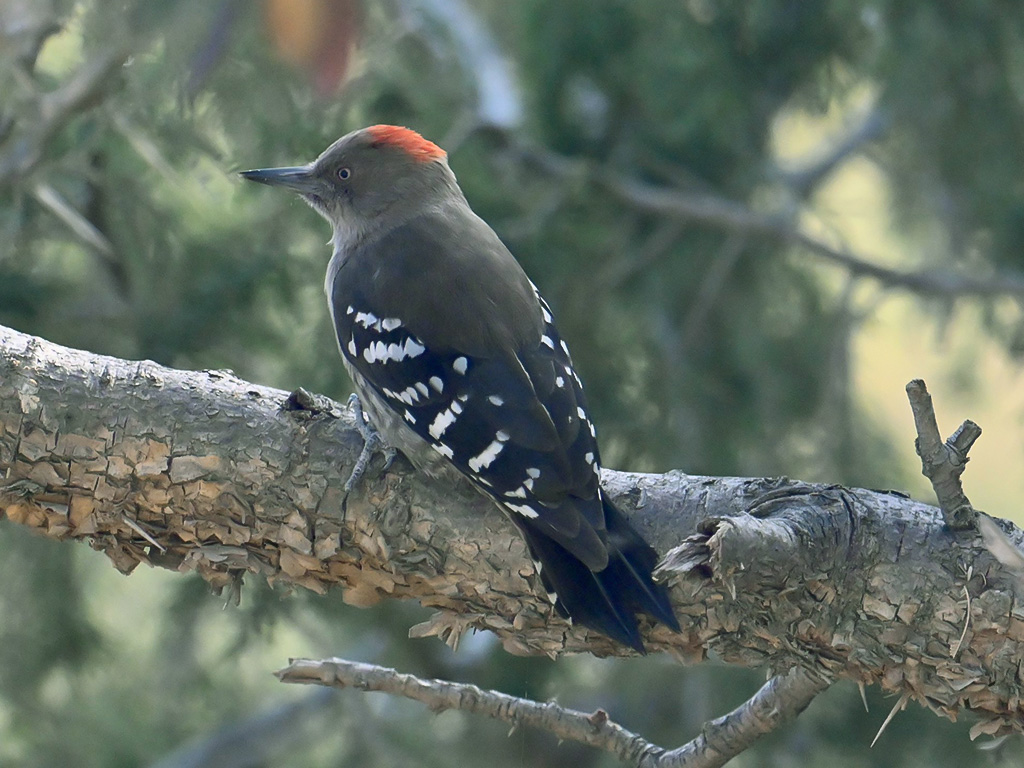
The Arabian woodpecker, also known as the Sarat Woodpecker, is a species of bird that resides in the Sarawat Mountains of Saudi Arabia and Yemen.
It’s unique to this region because it’s the only woodpecker that breeds on the Arabian Peninsula.
The American naturalist George Latimer Bates and Scottish zoologist Norman Boyd Kinnear were credited with its discovery when they described it and gave it scientific name: Dendrocoptes dorae in 1935.
This small bird has black plumage with white patches along its wings while its head has yellowish-orange feathers.
Its beak is short but strong enough for drilling into trees where they feed on insects like ants, beetles and termites found under bark or near dead branches.
They are also known to build their nests inside tree trunks by hollowing them out first before making their home there; thus helping promote healthier forest growth by creating space for new saplings to sprout from within these old hollowed logs.
Scientific classification:
| Kingdom | Animalia |
| Phylum | Chordata |
| Class | Aves |
| Order | Piciformes |
| Family | Picidae |
| Genus | Dendrocoptes |
| Species | D. dorae |
2. Arabian Wheatear
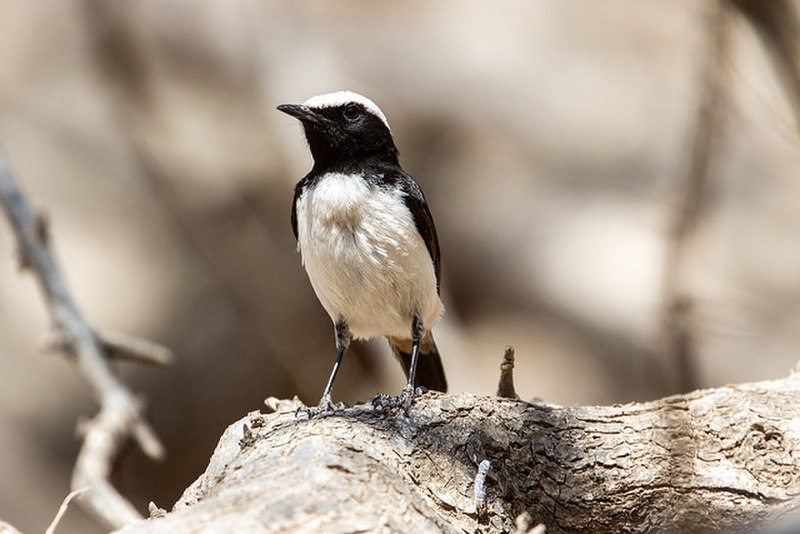
The Arabian wheatear is a species of bird in the family Muscicapidae, found mainly in Oman, Saudi Arabia and Yemen. This small passerine has an overall grey-brown coloration on its head and upperparts with white underside.
It also has two distinct black stripes down each side of its face from eyes to chin, giving it a unique look amongst other birds in the region. Its diet consists mostly of insects but can include berries as well.
The Arabian Wheatear breeds during spring into summer months when there are plenty of food sources around for them to feed their young ones and survive through winter months.
Conservation efforts have been made by local governments to protect this species due to increasing threats such as habitat loss caused by urbanization or climate change which affects prey availability leading towards population decline over time if unchecked properly.
Scientific classification:
| Kingdom | Animalia |
| Phylum | Chordata |
| Class | Aves |
| Order | Passeriformes |
| Family | Muscicapidae |
| Genus | Oenanthe |
| Species | O. lugentoides |
3. Asir Magpie
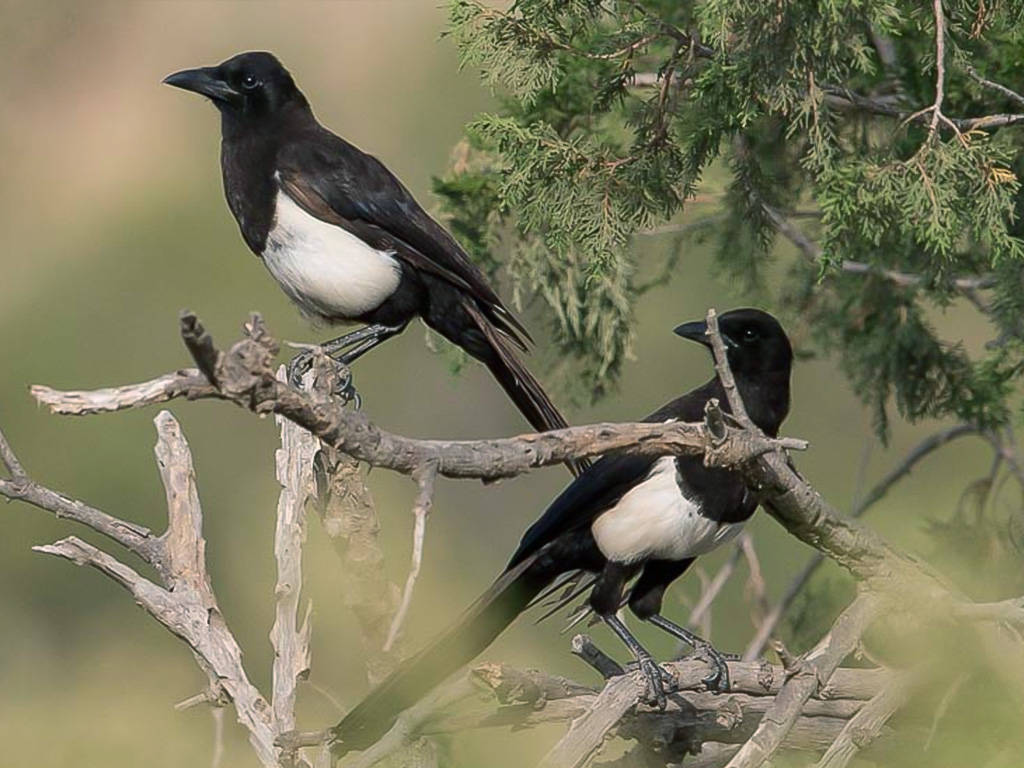
The Asir magpie is an endangered species of bird found only in the southwestern highlands of Saudi Arabia. Its habitat includes African juniper forest and well-vegetated wadis and valleys.
The size of this species is slightly smaller than that of a Eurasian magpie, with black feathers on its back, wings and tail while sporting white underparts. It has distinctive yellow bills with greyish legs.
While it was formerly classified as a subspecies to the Eurasian Magpie, many authorities now recognize it as distinct from them due to differences in plumage patterning among other characteristics.
This beautiful bird plays an important role within its ecosystem yet faces continuous threats such as destruction or degradation of essential habitats or poaching for illegal trade purposes which have caused drastic population declines across the globe making their future uncertain.
Scientific classification:
| Kingdom | Animalia |
| Phylum | Chordata |
| Class | Aves |
| Order | Passeriformes |
| Family | Corvidae |
| Genus | Pica |
| Species | P. asirensis |
4. Arabian Serin
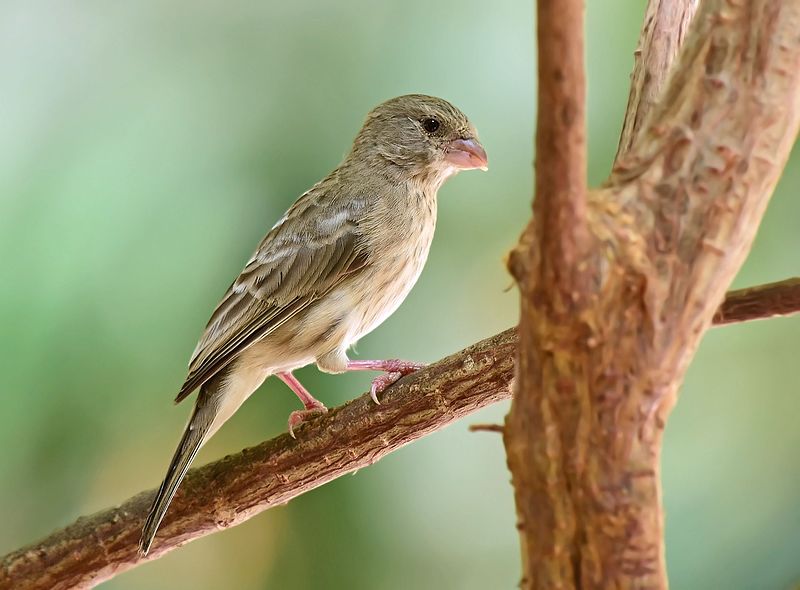
The Arabian Serin is a beautiful species of finch native to the Sarawat Mountains in western Saudi Arabia and Yemen. It can be found living among subtropical dry forests or shrublands, where it feeds on seeds and insects.
Its plumage consists of olive-brown upperparts with dark streaks, bright yellow underparts, and a distinctive rump patch that ranges from greenish-olive to greyish in color.
While not globally threatened at this time, its population has been declining due to habitat loss caused by human activity such as urbanization and agricultural expansion.
Conservation efforts are needed for the long term survival of this lovely bird.
Scientific classification:
| Kingdom | Animalia |
| Phylum | Chordata |
| Class | Aves |
| Order | Passeriformes |
| Family | Fringillidae |
| Subfamily | Carduelinae |
| Genus | Crithagra |
| Species | C. rothschildi |
5. Philby’s Partridge
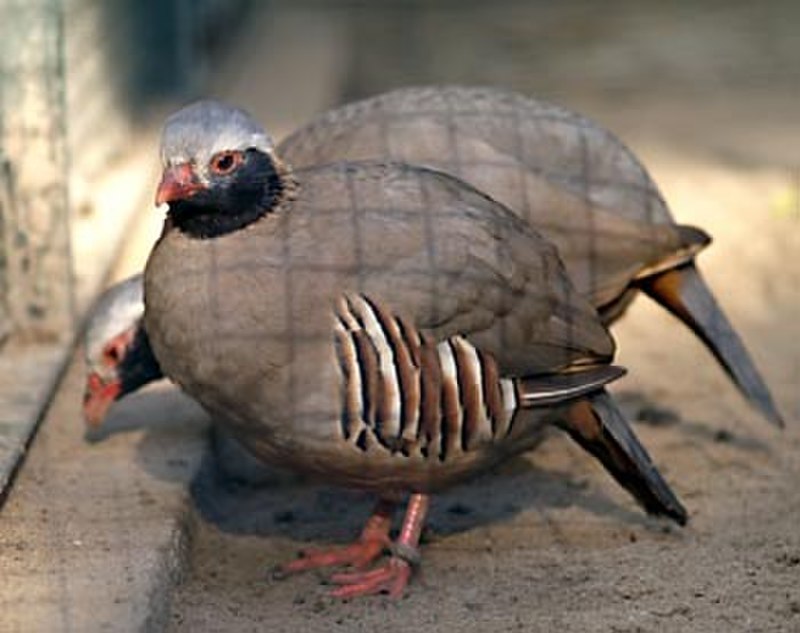
Philby’s partridge, also known as Philby’s rock partridge is a relative of the chukar, red-legged and barbary partridges. It is native to southwestern Saudi Arabia and northern Yemen where it can be distinguished by its black cheeks and throat.
Although not listed as endangered species yet, its population has been declining due to overgrazing, hunting and habitat destruction in recent years.
The Arab Wildlife Society (AWS) have taken up initiatives such as making protected areas for this bird in order to prevent further decline of this beautiful creature from our planet.
Conservation efforts like planting trees that provide food sources for these birds should help their numbers increase again so we will continue seeing them around us more often.
Scientific classification:
| Kingdom | Animalia |
| Phylum | Chordata |
| Class | Aves |
| Order | Galliformes |
| Family | Phasianidae |
| Genus | Alectoris |
| Species | A. philbyi |
6. Arabian Partridge
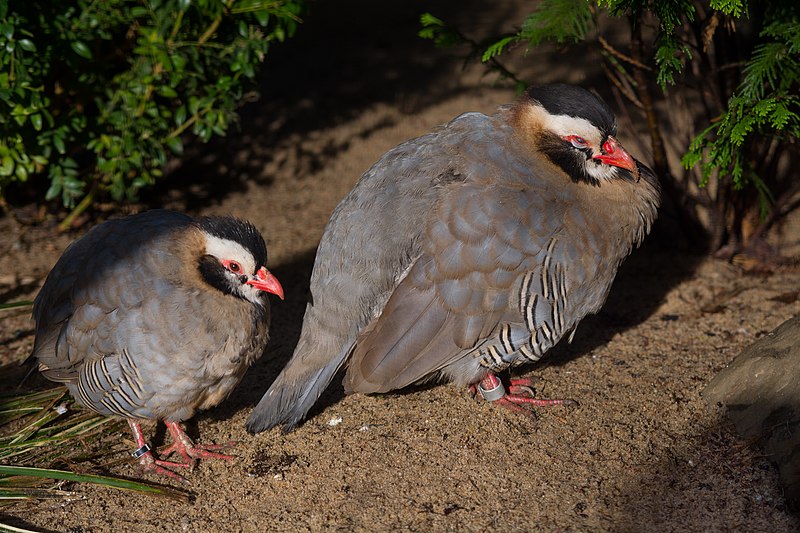
The Arabian partridge is a bird of the family Phasianidae, found in the southern Arabian peninsula. It has two recognised subspecies and can even hybridise with other species like Philby’s Partridge and Rock Partridges.
Larger than its relatives, this species has brown crowns on its head that contrast with their white cheeks. They also have barred black-and-white wings as well as greyish underparts which make them easy to spot in nature.
The males are known for making loud calls during mating season while females lay eggs mainly between March and May each year in dry open shrubland areas or deserts where they feed on seeds, fruits and insects according to seasonal availability.
Scientific classification:
| Kingdom | Animalia |
| Phylum | Chordata |
| Class | Aves |
| Order | Galliformes |
| Family | Phasianidae |
| Genus | Alectoris |
| Species | A. melanocephala |
7. Arabian Waxbill
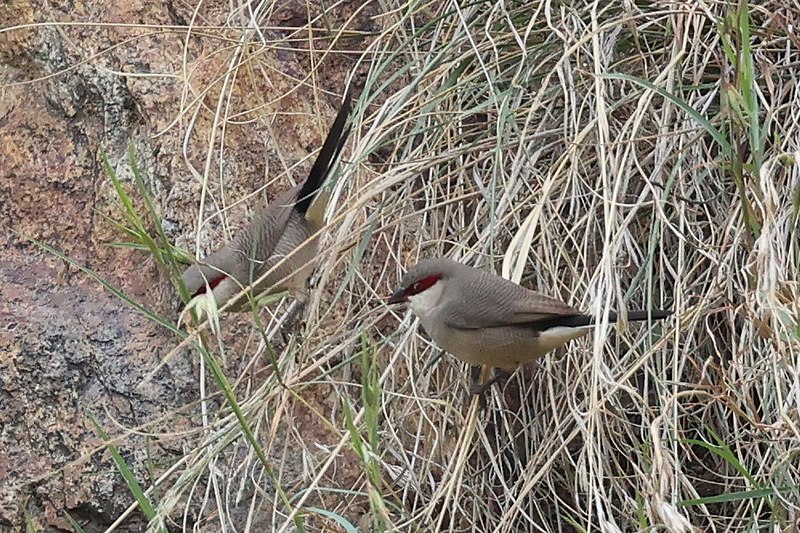
The Arabian waxbill is an estrildid finch native to Yemen and south-western Saudi Arabia, with a global extent of occurrence of 20,000 – 50,000 km2. This highly sociable bird inhabits wetter land in southern Tihamah foothills as well as the terraced slopes and wadis of western escarpments.
It has olive-brown plumage on its upperparts which gradually fades into greyish white towards its belly area. The head features bright red bill and eyes with pale yellow face patch bordered by black stripes that trail from behind the eye down to nape region.
Its wings are short yet pointed while legs are pinkish brown in colour with small claws at the end for clinging onto branches or stalks when perched upon them during feeding or nesting activities.
Scientific classification:
| Kingdom | Animalia |
| Phylum | Chordata |
| Class | Aves |
| Order | Passeriformes |
| Family | Estrildidae |
| Genus | Estrilda |
| Species | E. rufibarba |
8. Yemen Thrush
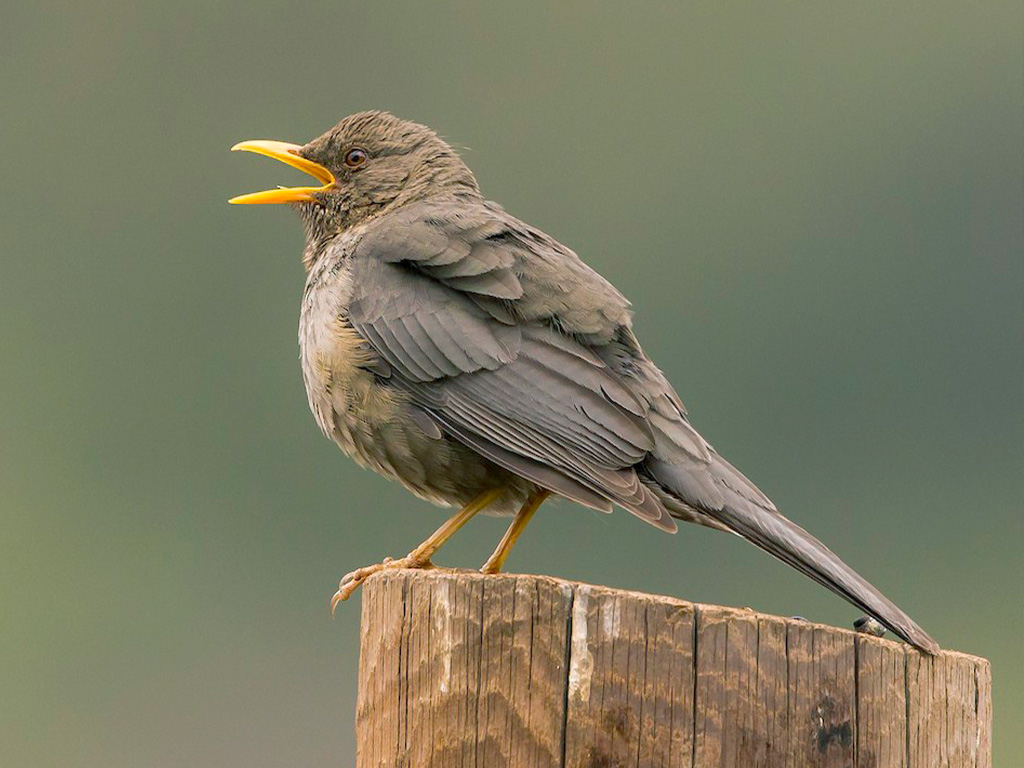
The Yemen thrush is a beautiful bird, belonging to the thrush family. It can be found in the Sarawat Mountains of western Arabia and has distinctive features such as its grey-brown upperparts, white underparts with black streaks, and chestnut undertail coverts.
Its diet consists mainly of insects and larvae which it finds by hopping along branches and foliage on the ground. The male’s song is melodious but not very loud; it starts off slow then speeds up towards end before returning back to start again at slower pace.
This species appears quite tolerant of human presence though they tend to keep away from areas where people are present due to disturbances caused by them.
They form pairs during breeding season that last between April through August when males perform courtship displays like fanning their tails while singing loudly for potential mates.
Scientific classification:
| Kingdom | Animalia |
| Phylum | Chordata |
| Class | Aves |
| Order | Passeriformes |
| Family | Turdidae |
| Genus | Turdus |
| Species | T. menachensis |
9. Yemen Linnet
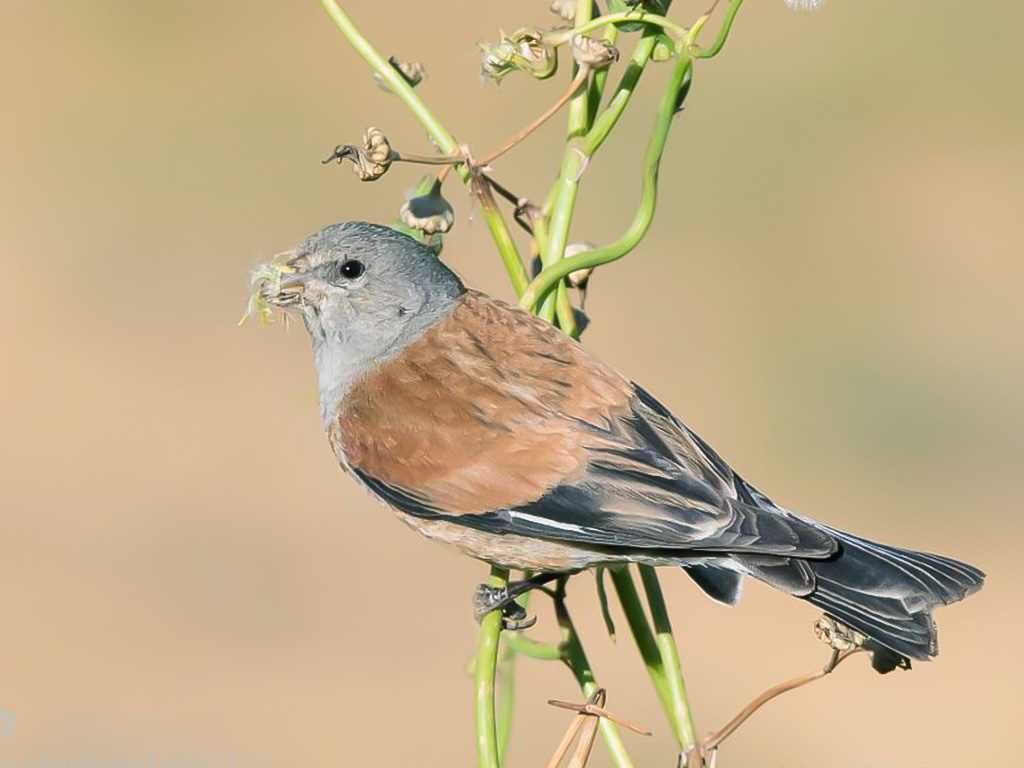
The Yemen linnet is a species of finch that can be found in Saudi Arabia and Yemen. It inhabits dry shrublands, making it an adept survivor in hot climates.
The bird was formerly placed in the genus Carduelis but has since been moved to its own genus Linaria due to differences revealed by DNA sequencing analyses.
These studies showed how this species differs from other birds within the family Fringillidae, which includes many types of finches and sparrows.
Its plumage consists mainly of grey or brown feathers with some yellow patches on its wings and around its eyes, giving it unique features compared to related species.
Scientific classification:
| Kingdom | Animalia |
| Phylum | Chordata |
| Class | Aves |
| Order | Passeriformes |
| Family | Fringillidae |
| Subfamily | Carduelinae |
| Genus | Linaria |
| Species | L. yemenensis |
10. Yemen Serin
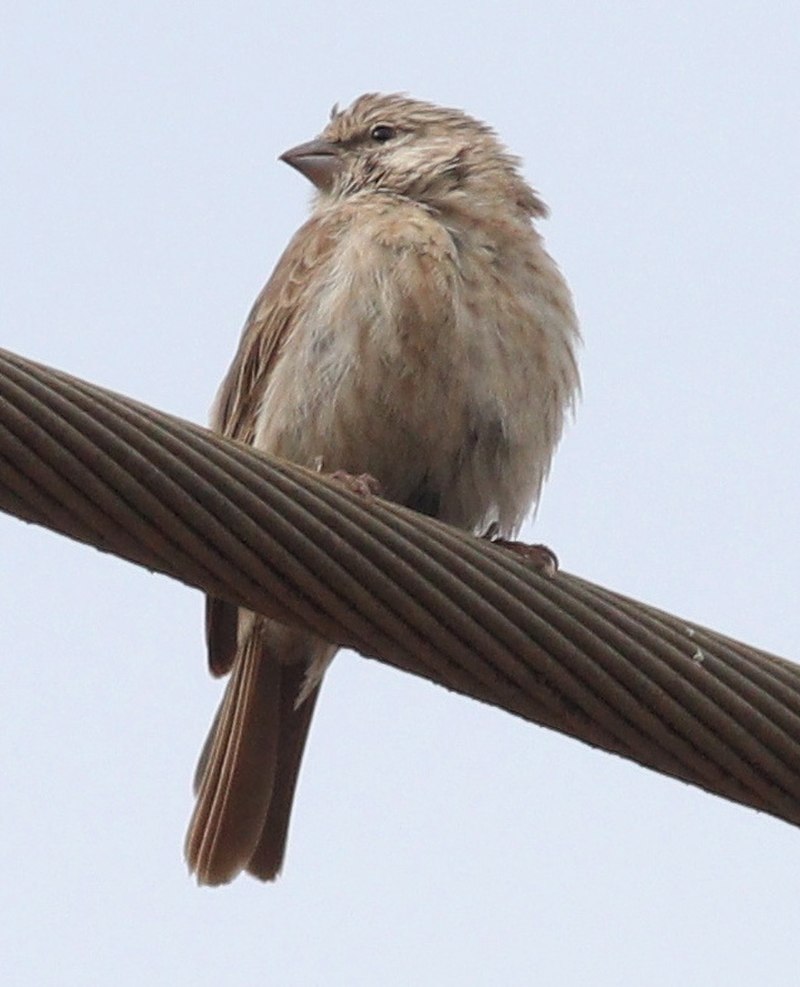
The Yemen Serin is a species of finch that can be found in countries such as Oman, Saudi Arabia and Yemen.
It was previously grouped into the genus ‘Serinus’, but after an analysis involving both mitochondrial and nuclear DNA sequences it became apparent this grouping was not accurate.
As a result the genus has been split with various species including the Yemen Serin being moved to their own distinct groupings.
The bird has yellow wings and face along with dark green upperparts making for quite a colourful look overall.
They mainly feed on seeds from plants or insects which they find whilst foraging through grasslands or semi-arid habitats near water sources such as ponds or streams.
Scientific classification:
| Kingdom | Animalia |
| Phylum | Chordata |
| Class | Aves |
| Order | Passeriformes |
| Family | Fringillidae |
| Subfamily | Carduelinae |
| Genus | Crithagra |
| Species | C. menachensis |
11. Shrike
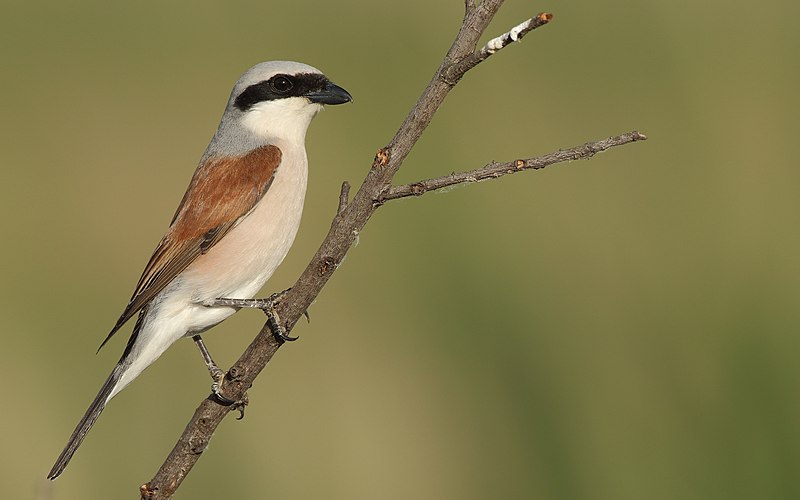
Shrikes are small passerine birds of the family Laniidae, with 34 species in four genera. They get their name from Old English word “scrīc”, which refers to their shriek-like call.
These birds have earned the nickname ‘butcherbirds’ due to their feeding habits; they impale prey on thorns or barbed wire fences for later consumption.
Shrikes also tend to be aggressive predators and hunt a wide range of animals such as insects, small reptiles, rodents and even other smaller bird species.
In terms of physical appearance, these songbirds can vary greatly depending on the specific genus but usually boast a large hooked bill atop an impressive crest along with bright colors like gray, black or brownish hues across its feathers.
It’s clear shrike is quite remarkable creature that has gained notoriety for both hunting prowess and distinctive vocalizations.
Scientific classification:
| Kingdom | Animalia |
| Phylum | Chordata |
| Class | Aves |
| Order | Passeriformes |
| Superfamily | Corvoidea |
| Family | Laniidae Rafinesque, 1815 |
12. Yemen Warbler
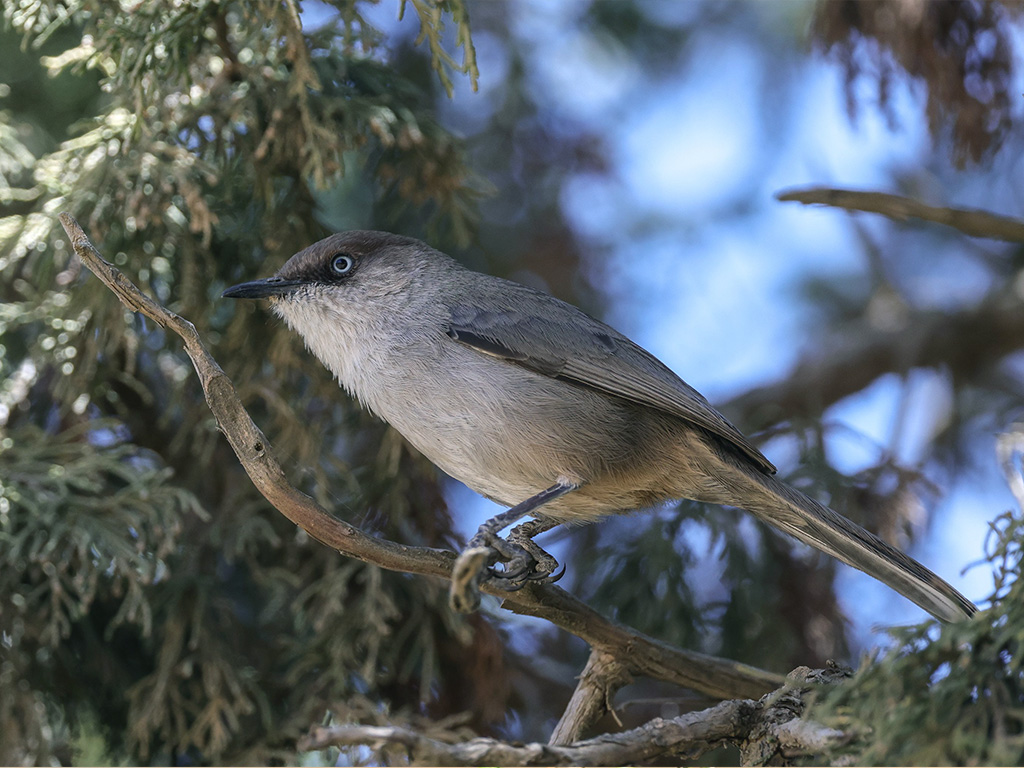
The Yemen Warbler is a small bird found in the dry forests of southeast Sarawat Mountains of Yemen and Saudi Arabia. It belongs to Old World warbler family Sylviidae and has an average length between 11-12 cm.
The upper parts are brownish gray with dark streaks on head, neck, back and wings whereas its underparts are whitish grey. Its tail is short but pointed at the end with white feathers underneath it giving it a spectacular look when flying or perched on tree branches.
Due to rapid habitat loss due to human activities like deforestation, this species faces a high risk of extinction as per International Union for Conservation of Nature (IUCN).
Thus concerted efforts must be taken by governments and local communities alike to protect them from such imminent threat.
Scientific classification:
| Kingdom | Animalia |
| Phylum | Chordata |
| Class | Aves |
| Order | Passeriformes |
| Family | Sylviidae |
| Genus | Curruca |
| Species | C. buryi |
13. Arabian Scops Owl
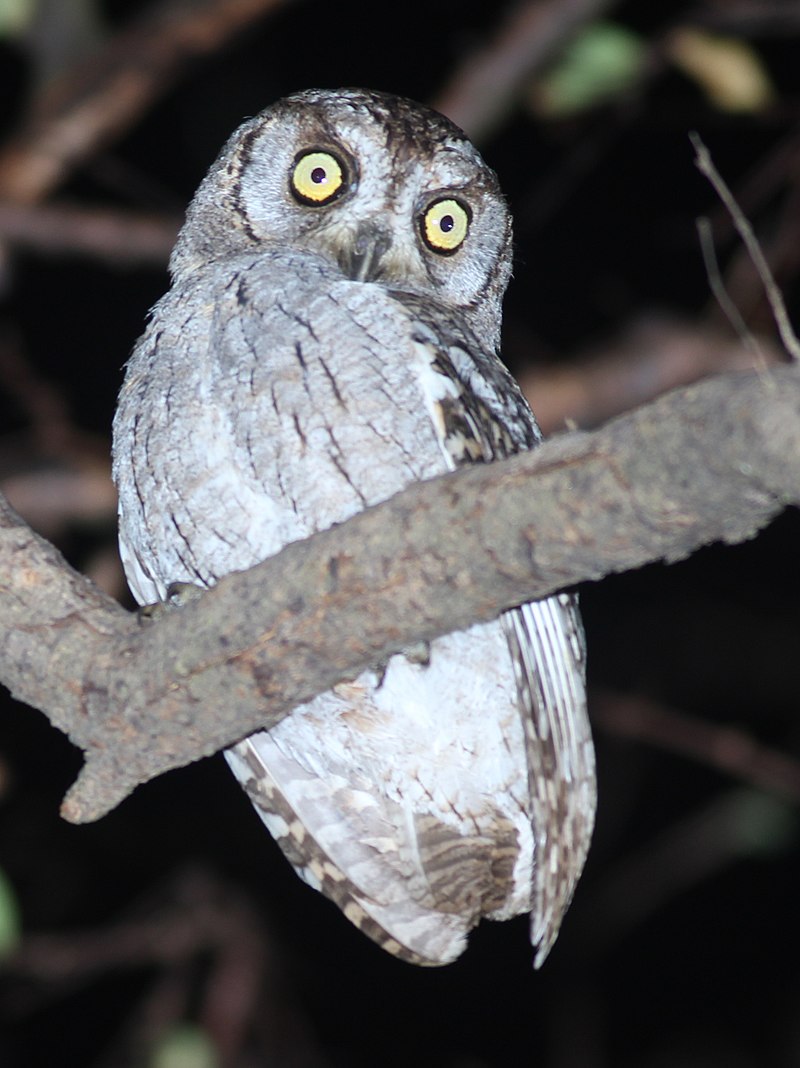
The Arabian Scops Owl is a small, unique species of owl found in Saudi Arabia, Oman and Yemen. With an estimated population of 60,000 individuals, it’s one of the few endemic birds to this region.
The scops owl stands at about 18 cm tall with grey-brown feathers on its back and pale yellow or white undersides. It has large dark eyes that help it hunt for prey in low light conditions such as dusk or dawn when most other animals are asleep.
During the day time they often hide high up in trees where their camouflage helps them blend into their surroundings unnoticed by predators like hawks and eagles who may mistake them for branches. They feed mainly on insects but also eat rodents occasionally too which makes them great natural pest controllers.
Scientific classification:
| Kingdom | Animalia |
| Phylum | Chordata |
| Class | Aves |
| Order | Strigiformes |
| Family | Strigidae |
| Genus | Otus |
| Species | O. pamelae |
14. Rüppell’s Weaver
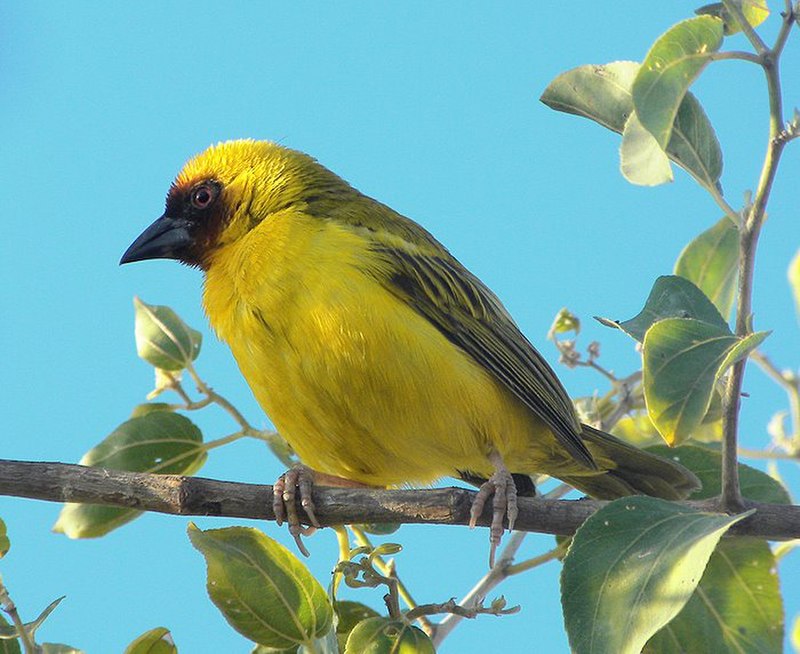
Rüppell’s weaver is a species of bird in the Ploceidae family, native to northern Afrotropics. It was named after German zoologist and explorer Eduard Rüppell.
The range for this species includes Sudan, Somalia and extreme northern Kenya, as well as the south-western Arabian Peninsula.
In Degua Tembien mountains in north Ethiopia it can be seen at high altitudes up to 3200m above sea level.
This small bird has impressive yellowish-green plumage with dark streaks on its chest and back; males may have some orange coloration too.
Their song consists of chirps that get louder towards the end, making them easily recognizable among other members of their family.
As they are highly social birds they often flock together while nesting or feeding on insects such as grasshoppers or beetles near agricultural fields or pastures.
Scientific classification:
| Kingdom | Animalia |
| Phylum | Chordata |
| Class | Aves |
| Order | Passeriformes |
| Family | Ploceidae |
| Genus | Ploceus |
| Species | P. galbula |
15. Arabian Golden Sparrow
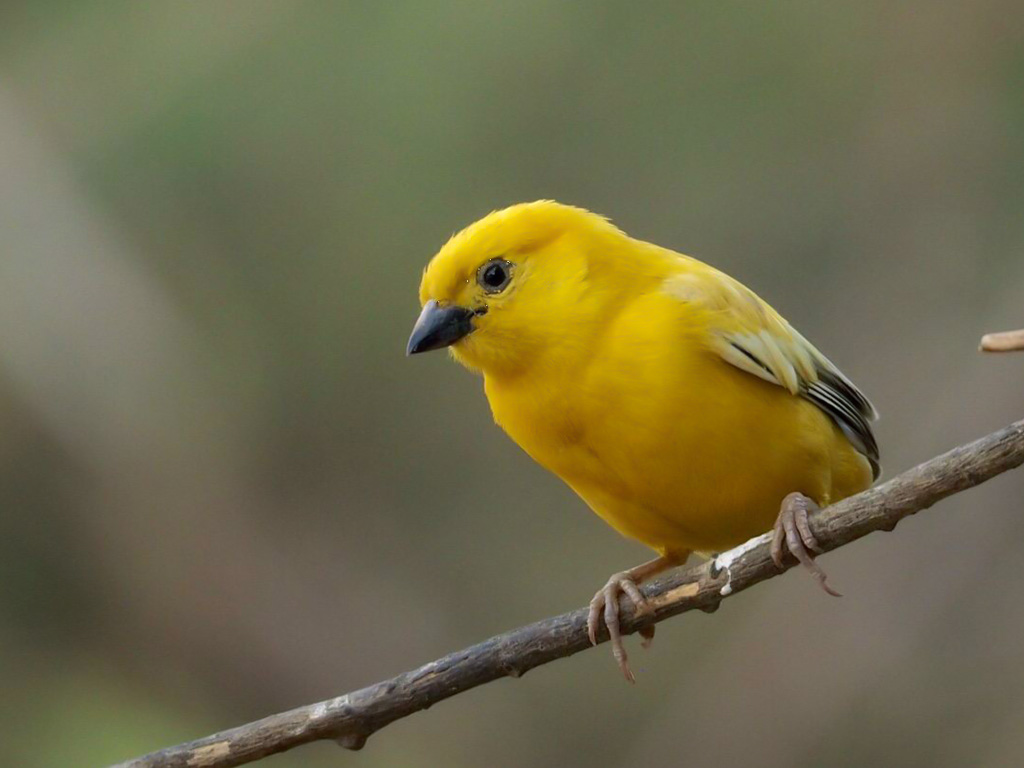
The Arabian golden sparrow is a small, seed-eating bird native to south west Arabia, Somalia and Djibouti. It lives in thorn savannahs and scrub habitats which provide it with plenty of food sources.
Its striking colouration makes it stand out from other birds – gold feathers on its back give way to white ones on the underside. The wings are also tipped in black making them easy to spot when they take flight.
While similar species have been found elsewhere in Africa, this particular subspecies is only known from these three countries where populations remain steady but vulnerable due to their limited range size.
Conservation efforts should focus on protecting suitable habitat for the Arabian golden sparrow so that future generations can enjoy this beautiful creature’s presence as much as we do today.
Scientific classification:
| Kingdom | Animalia |
| Phylum | Chordata |
| Class | Aves |
| Order | Passeriformes |
| Family | Passeridae |
| Genus | Passer |
| Species | P. euchlorus |
16. Crab-Plover
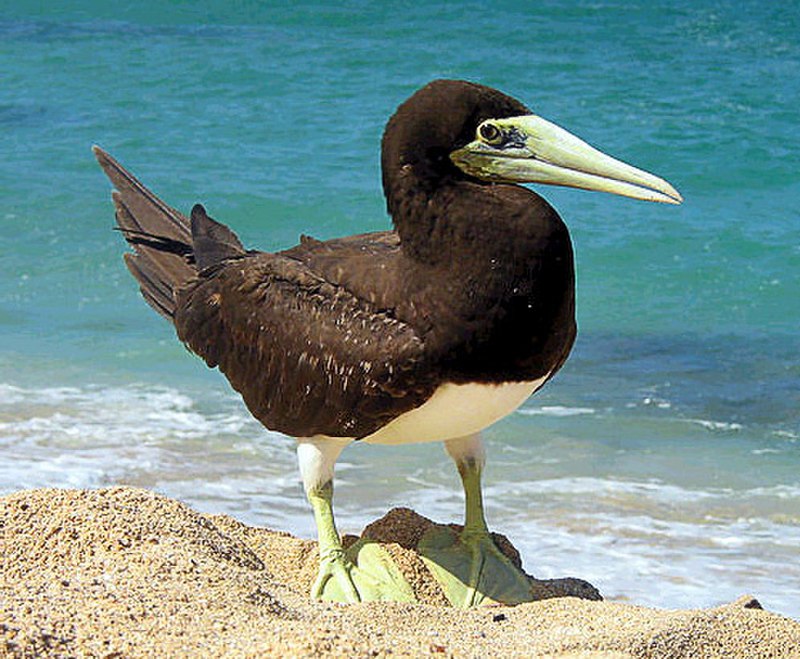
The crab-plover is an exceptional bird which belongs to its own family, Dromadidae. It appears to be closely related to the waders and other Charadriiformes such as auks, gulls and thick-knees.
This species of bird has a unique look; it is white with black markings on its head and wings. Its long bill helps them dig for food in sand or mudflats.
They can also fly up into the air when disturbed by predators or people too close for comfort.
The crab plover spends most of its life near beaches where they feed on crabs, fish eggs and small insects found there.
These birds are highly social during breeding season but solitary at other times throughout their annual cycle making them difficult creatures to spot out in the wild but well worth trying.
Scientific classification:
| Kingdom | Animalia |
| Phylum | Chordata |
| Class | Aves |
| Order | Charadriiformes |
| Suborder | Lari |
| Family | Dromadidae GR Gray, 1840 |
| Genus | Dromas Paykull, 1805 |
| Species | D. ardeola |
17. Egyptian Nightjar
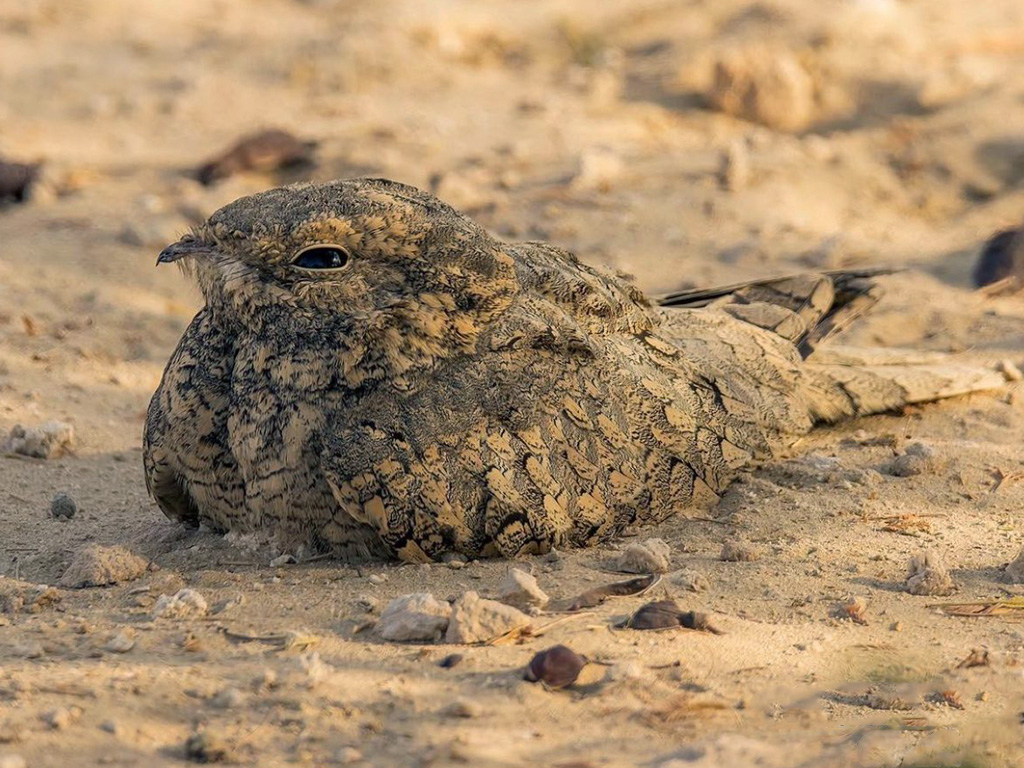
The Egyptian nightjar is a medium-sized nocturnal bird native to Southwest Asia and North Africa.
It migrates to tropical Africa during the winter months, where it can be seen in open woodlands as well as savannas and semi-desert environments.
This species has an extensive range with no major threats, so its conservation status is rated “least concern” by the IUCN.
The adult birds have distinctive white speckles on their wings and backs which help them blend into sandy or rocky habitats while they sleep during the day.
They feed mainly on insects such as moths, beetles, crickets and grasshoppers at night time when they are most active. With a little luck you may spot one of these mysterious creatures flying around after dusk.
Scientific classification:
| Kingdom | Animalia |
| Phylum | Chordata |
| Class | Aves |
| Order | Caprimulgiformes |
| Family | Caprimulgidae |
| Genus | Caprimulgus |
| Species | C. aegyptius |
18. Hamerkop
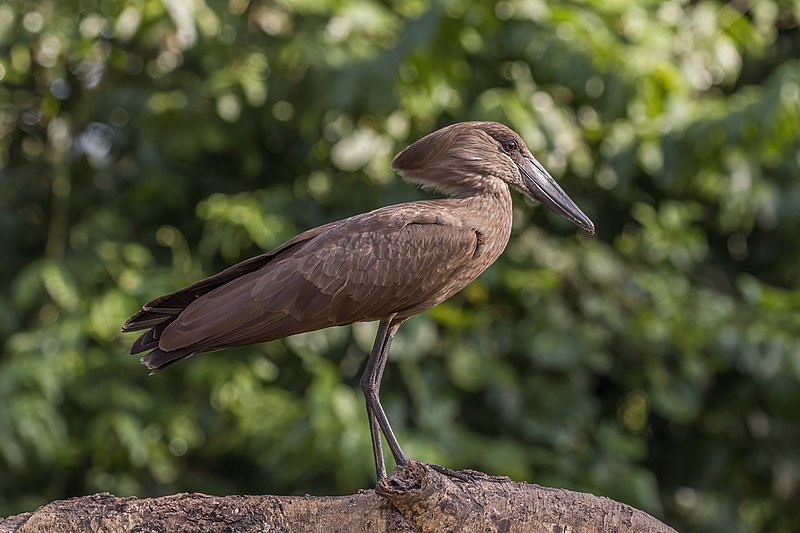
The Hamerkop is a unique wading bird found across sub-Saharan Africa and as far east as India.
It has an unmistakable silhouette, with its long bill topped by a crest at the back of its head that gives it the look of a hammerhead shark.
Its plumage consists mainly of browns and greys, providing excellent camouflage in reed beds.
The species was once classified alongside storks but is now believed to be closely related to pelicans and shoebills instead.
This medium-sized bird feeds on insects, fish, frogs or small reptiles which it captures from shallow water or plucks from trees near bodies of water.
Despite being considered ‘unlucky’ by some cultures due to superstition surrounding their appearance they are actually quite important for controlling populations of certain pests.
Scientific classification:
| Kingdom | Animalia |
| Phylum | Chordata |
| Class | Aves |
| Order | Pelecaniformes |
| Family | Scopidae |
| Genus | Scopus |
| Species | S. umbretta |
19. Pharaoh Eagle-Owl
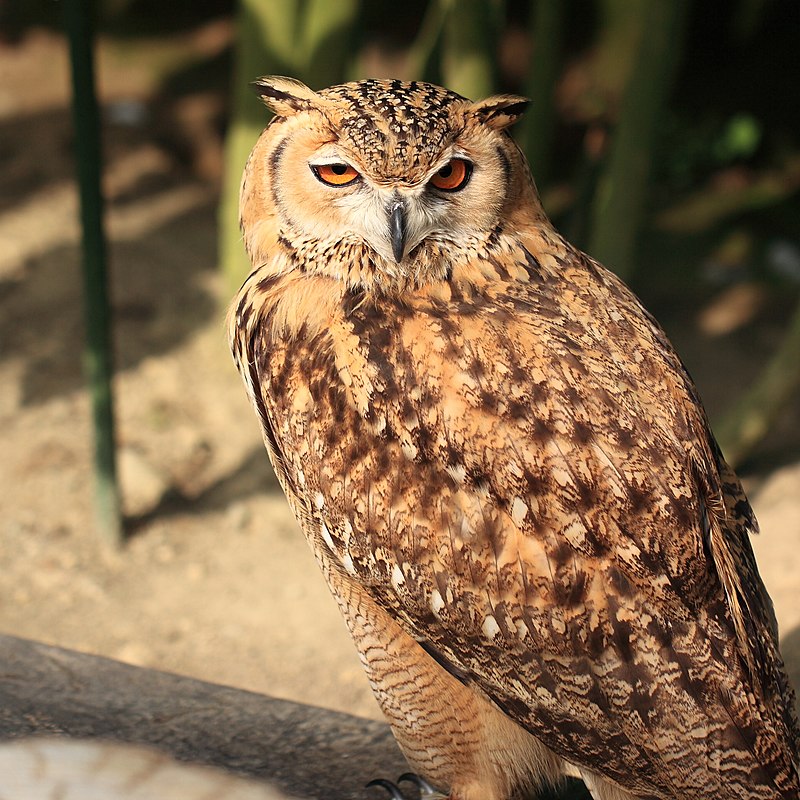
The Pharaoh eagle-owl is a majestic bird native to North Africa and the Middle East. It has an impressive plumage of mottles, with large orange-yellow eyes that add to its regal appearance.
Its head and upperparts are covered in dark brown feathers which contrast nicely against the paler chestnut colored underparts.
The wingspan can reach up to 80 cm wide, making it one of the larger species of owl found in this region.
In addition, they have strong talons used for catching their prey such as small mammals or reptiles while they hunt at night during twilight hours when most other birds are asleep.
Their call is deep and loud; a haunting hoot often heard echoing through deserts at dusk or dawn.
Scientific classification:
| Kingdom | Animalia |
| Phylum | Chordata |
| Class | Aves |
| Order | Strigiformes |
| Family | Strigidae |
| Genus | Bubo |
| Species | B. ascalaphus |
20. Common Pochard
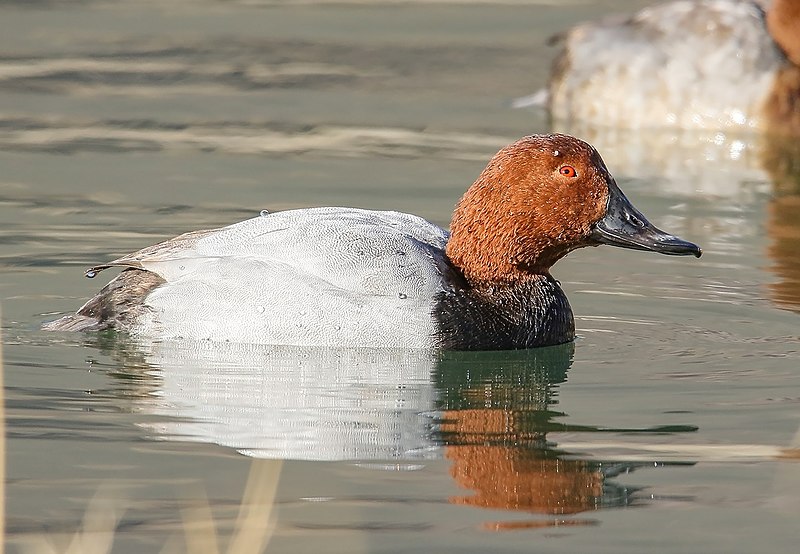
The Common Pochard is a medium-sized diving duck found across Eurasia and North Africa. It has distinctive features such as a long, dark bill with a grey band, red head and neck, black breast, red eyes and grey back.
The female has similar characteristics but her head is more brown/grey in colour than the male’s striking red hue.
They are often seen swimming together in large flocks near freshwater bodies or on lakes to feed on aquatic plants like seeds of waterlilies etc., which makes them an important part of the ecosystem by helping disperse plant species.
Their loud call can be heard over vast distances making them easy to spot even when they’re far away.
Scientific classification:
| Kingdom | Animalia |
| Phylum | Chordata |
| Class | Aves |
| Order | Anseriformes |
| Family | Anatidae |
| Genus | Aythya |
| Species | A. ferina |
Also Featured In: Native Birds of Kazakhstan, Belarus Birds You Should Know
21. Red-Breasted Wheatear
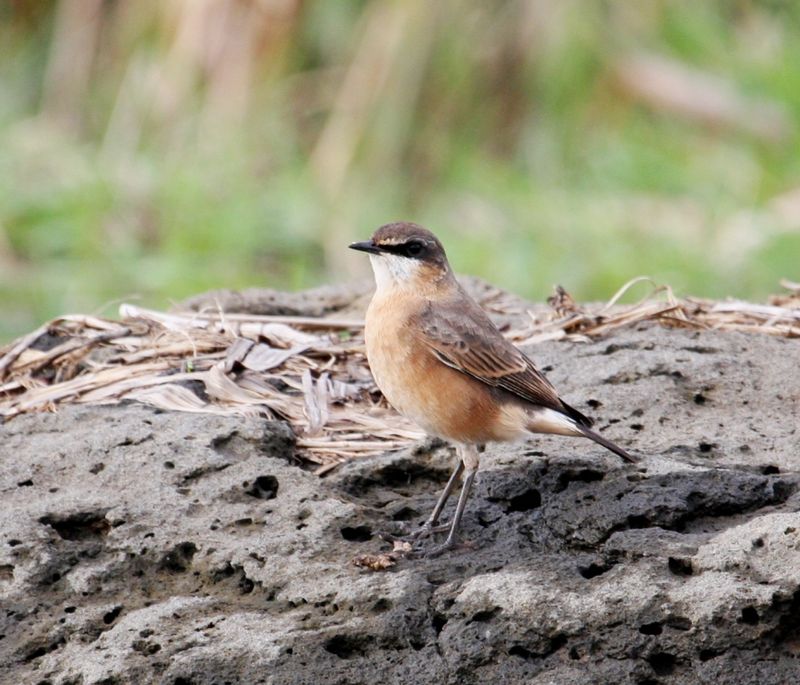
The red-breasted wheatear is a species of bird from the family Muscicapidae, also known as Botta’s wheatear or buff-breasted wheatear. It has rust brown feathers on its back and wings, with an orange breast and white underparts.
Its tail is black with a broad white terminal band that makes it easy to identify in flight.
This species can be found mainly in North Africa but occasionally ranges up towards Europe during migration season; they often inhabit grassy areas near water sources such as rivers and lakes where their main diet consists of insects and small invertebrates.
They are similar in appearance to Heuglin’s Wheatear (Oenanthe heuglini), although much smaller than them, while the Rusty-breasted Wheatear (Oenanthe frenata) share many similarities too but have different plumage colours compared to Red-Breasteds’.
Scientific classification:
| Kingdom | Animalia |
| Phylum | Chordata |
| Class | Aves |
| Order | Passeriformes |
| Family | Muscicapidae |
| Genus | Oenanthe |
| Species | O. bottae |
22. Socotra Cormorant
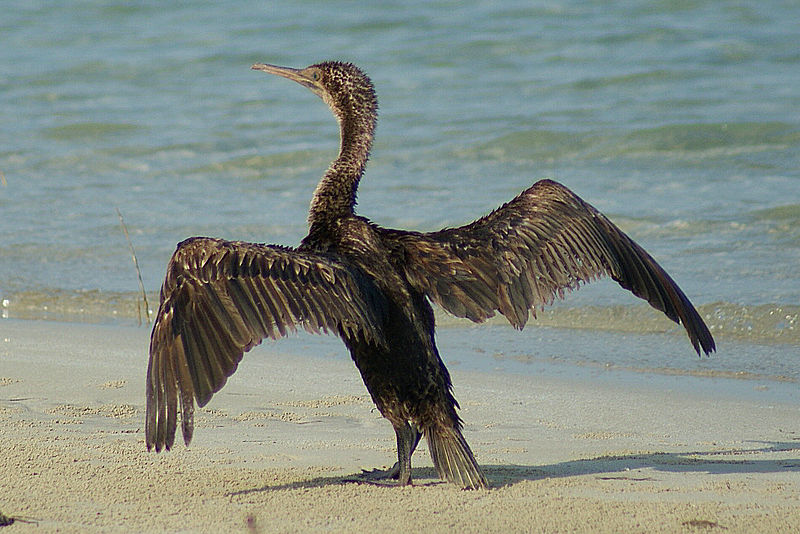
The Socotra cormorant is a threatened species of bird endemic to the Persian Gulf and south-east coast of the Arabian Peninsula. It has also been sighted in the Red Sea, although it is not known to breed there.
The bird has grey feathers with white patches on its wings, neck and tail tip. Its beak and throat are black while its face and legs are yellowish-white.
Despite being named for Socotra Island (Yemen), where it used to live before becoming endangered due to hunting, nesting destruction by humans and predation by feral cats; it was only confirmed in 2005 that this species breeds here again today.
Scientific classification:
| Kingdom | Animalia |
| Phylum | Chordata |
| Class | Aves |
| Order | Suliformes |
| Family | Phalacrocoracidae |
| Genus | Phalacrocorax |
| Species | P. nigrogularis |
Also Featured In: Common Birds of Socotra,
23. Eastern Imperial Eagle
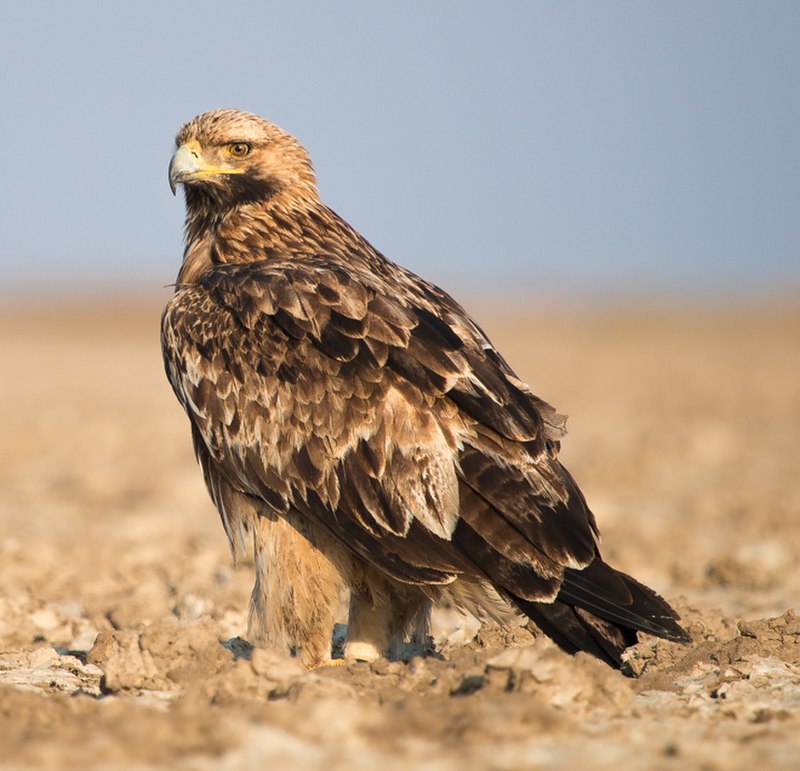
The Eastern Imperial Eagle is a majestic bird of prey, with striking features and sharp eyesight.
It breeds in southeastern Europe and throughout West and Central Asia, before migrating south to winter in Africa, the Middle East or South/East Asia.
This eagle belongs to the Accipitridae family – known for their well-feathered legs – allowing them great agility when hunting their prey which includes rabbits, hares and small mammals among other birds.
They have brown wings bordered by white feathers which gives it an elegant appearance that stands out from its environment.
In recent years there has been some concern about declining numbers due to loss of habitat or illegal poaching; however conservation efforts are underway to ensure this beautiful species continues into future generations.
Scientific classification:
| Kingdom | Animalia |
| Phylum | Chordata |
| Class | Aves |
| Order | Accipitriformes |
| Family | Accipitridae |
| Genus | Aquila |
| Species | A. heliaca |
Also Featured In: Imperial Birds You Should Know, Birds Found in Hungary
24. Arabian Warbler
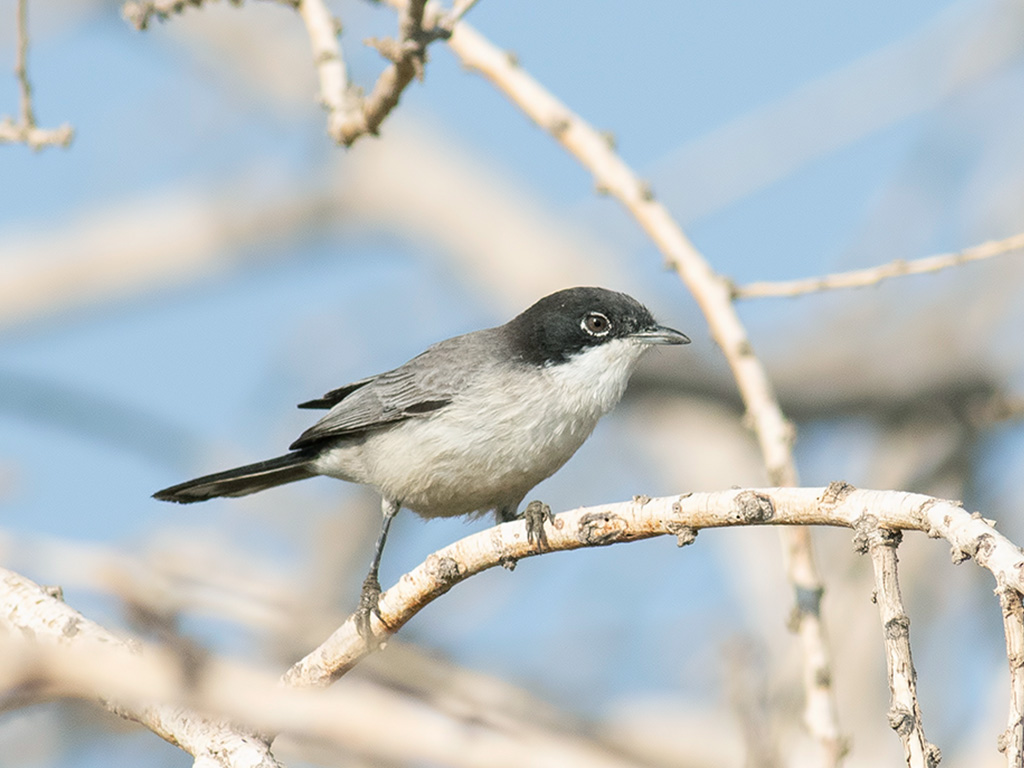
The Arabian Warbler is a species of Old World warbler found in Djibouti, Egypt, Eritrea, Israel, Jordan, Oman and Yemen.
It has four recognized subspecies: C. l. negevensis ,C. l. leucomelaena ,C .l edithae and C .l rufiventris which all inhabit dry savanna country dotted with Acacia trees typically found on the banks of rivers or near oases across its range countries.
The bird is quite small measuring only 9cm long when fully grown with males having greyish plumage while females have duller brown feathers although both genders feature reddish wings as well as tawny-buff underparts making it easy to spot them amongst the foliage they call home.
They are known for their melodic song which can be heard throughout summer months but during winter they migrate southwards to Africa where temperatures are more mild this behaviour helps ensure that new generations continue to thrive despite harsh desert conditions.
Scientific classification:
| Kingdom | Animalia |
| Phylum | Chordata |
| Class | Aves |
| Order | Passeriformes |
| Family | Sylviidae |
| Genus | Curruca |
| Species | C. leucomelaena |
25. Phasianidae
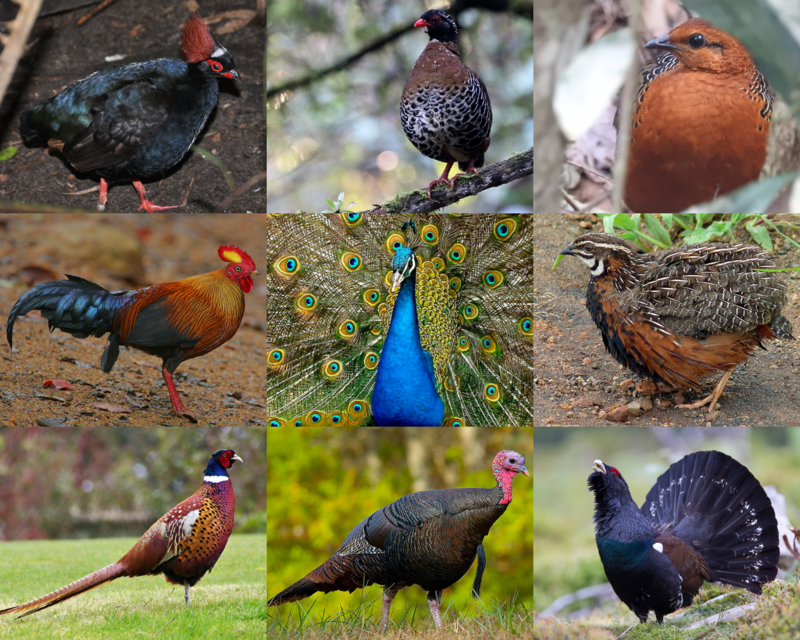
The Phasianidae family of birds is one that contains many popular gamebirds, with a total of 185 species divided across 54 genera.
These heavy ground-living birds include pheasants, partridges, junglefowl, chickens, and turkeys among others like Old World quail and peafowl.
This large family was formerly split into two subfamilies known as the Phasianinae and Perdicinae but this classification has since been changed to reflect more current scientific findings on them.
All these different types of birds have certain things in common such as their strong legs for scratching through leaves or soil looking for food items including insects, seeds, and other vegetation which makes up most of their diet.
They also all tend to be quite colorful in order to attract mates during breeding season when males will often display vibrant feathers or do dances around females in an attempt at courtship ritual displays.
The majority are monogamous creatures too although some may form short-term pair bonds before going off alone again once mating has taken place – either way.
There tends to be very little parental care given by adults after eggs have hatched so chicks need to fend for themselves right away.
Scientific classification:
| Kingdom | Animalia |
| Phylum | Chordata |
| Class | Aves |
| Order | Galliformes |
| Superfamily | Phasianoidea |
| Family | Phasianidae Horsfield, 1821 |
26. Sandgrouse
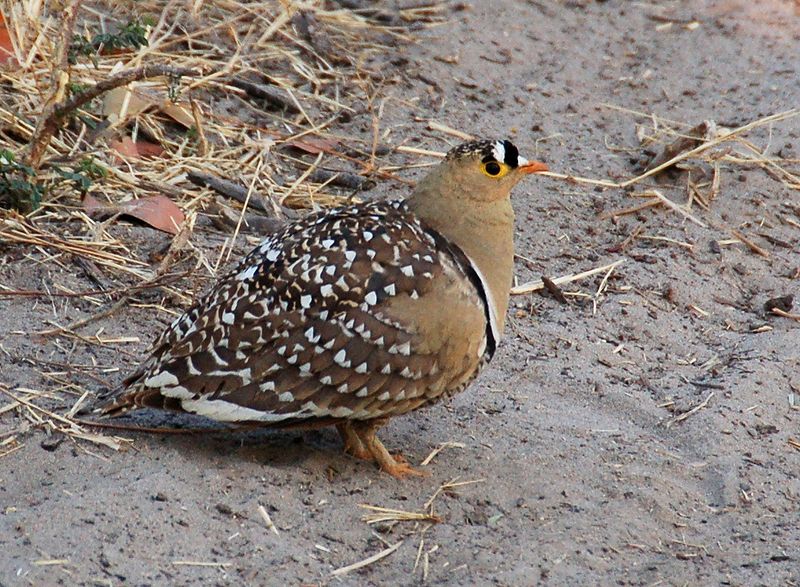
Sandgrouse is birds of the order Pterocliformes, found mainly in Africa and Asia. There are sixteen species belonging to two genera – Syrrhaptes from central Asia and Pterocles from Africa and other Asian countries.
They inhabit treeless areas such as deserts, steppes, scrubland, or savannas and tend to be ground-dwelling birds that feed on seeds.
Sandgrouse has adapted special features for survival in their harsh environment.
They possess well-developed feet with four toes used for walking over hot sand while keeping their body temperature cool at all times by regulating heat loss through their legs.
Their feathers also act like a sponge helping them absorb water before flying long distances back home where they then expel it using specialized glandular secretions located near the wings so that chicks can drink directly from an adult’s breast plumage.
Scientific classification:
| Kingdom | Animalia |
| Phylum | Chordata |
| Class | Aves |
| Clade | Columbimorphae |
| Order | Pterocliformes Huxley, 1868 |
| Family | Pteroclidae Bonaparte, 1831 |
27. Grebes
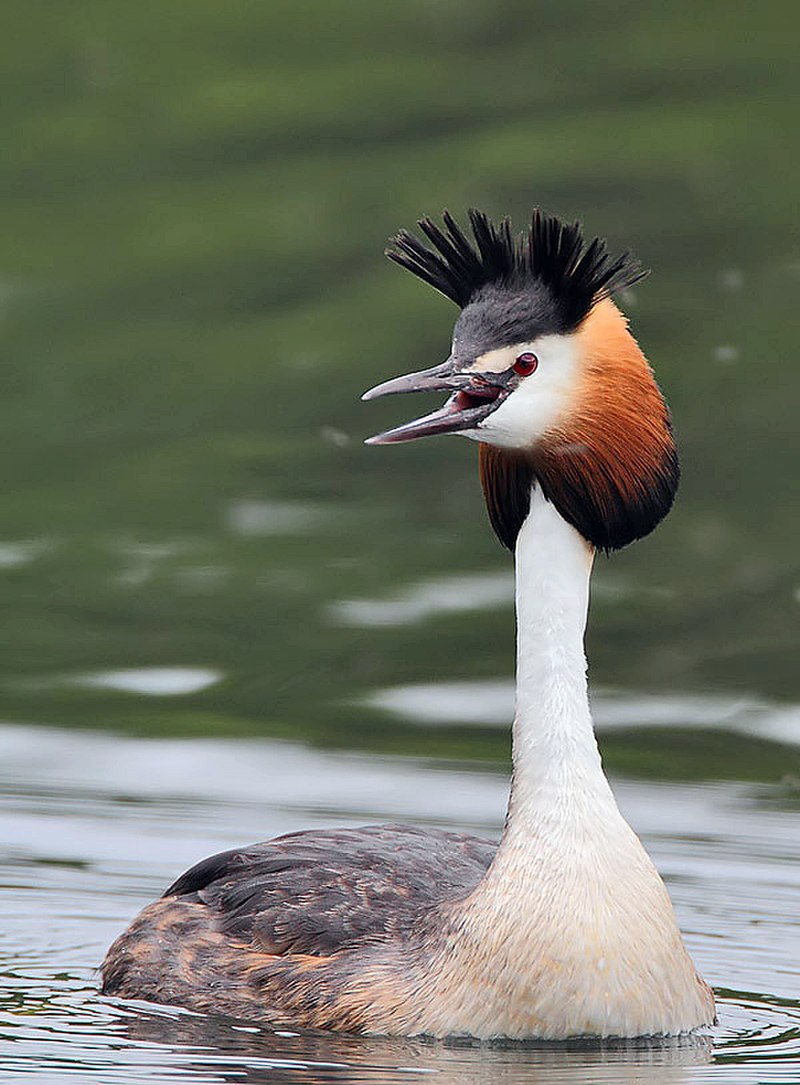
Grebes are a type of diving bird found in freshwater habitats around the world. They belong to the order Podicipediformes and have 22 species that exist across six genera.
Some species can also be found in marine environments during their migration or winter season, and some even live flightless lives on stable lakes.
Grebes vary greatly between regions; for example, they range from 4-32 inches long with anywhere from 8-30 ounces of weight depending on which species it is.
Their plumage may be black, browns/grays or whites but usually consist of bright colors such as yellows, blues and greens while underwater they use these feathers to help them streamline through the water quickly.
Scientific classification:
| Kingdom | Animalia |
| Phylum | Chordata |
| Class | Aves |
| Clade | Neoaves |
| Clade | Mirandornithes |
| Order | Podicipediformes Fürbringer, 1888 |
| Family | Podicipedidae Bonaparte, 1831 |
28. White-Tailed Lapwing
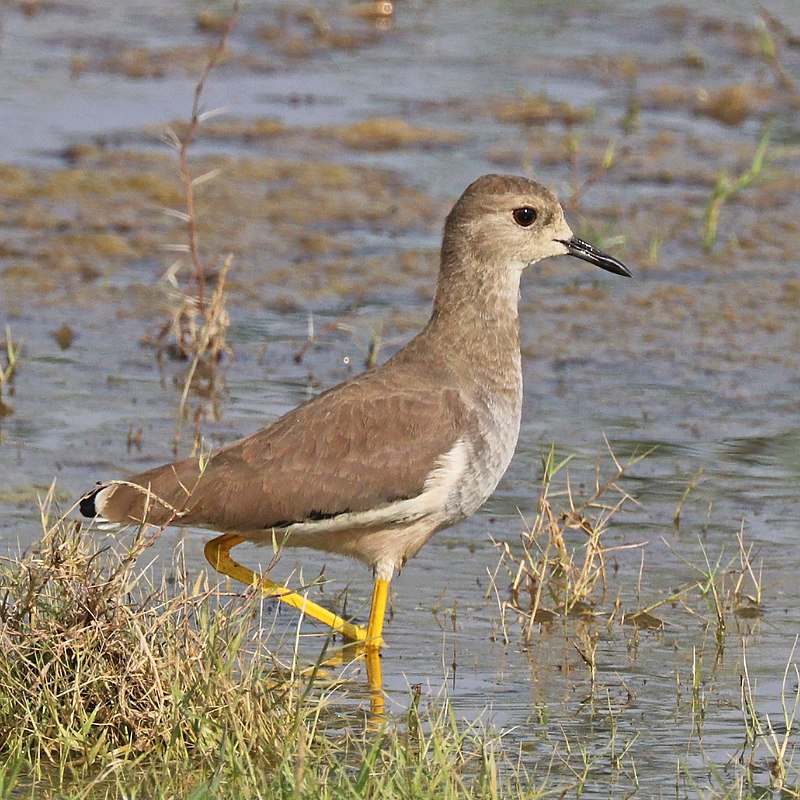
The White-tailed Lapwing is a stunning wader bird which belongs to the lapwing genus and can be identified by its long legs, long bill and striking white tail feathers.
Its Latin name Vanellus leucurus means ‘white tailed winnowing fan’ reflecting the birds habitat of open grassland meadows across Europe, Asia and Africa.
It feeds on insects in short vegetation or bare ground during breeding season but will also eat small invertebrates such as earthworms when available.
During nonbreeding season it spends most of its time roosting in flocks near water bodies like estuaries or lagoons where food sources are plentiful.
The species faces threats from human activities such as loss of wetland habitats due to pollution so conservation efforts should focus on protecting these areas for this beautiful creature’s future survival.
Scientific classification:
| Kingdom | Animalia |
| Phylum | Chordata |
| Class | Aves |
| Order | Charadriiformes |
| Family | Charadriidae |
| Genus | Vanellus |
| Species | V. leucurus |
Also Featured In: Birds That Live in Iraq, Birds that Live in Rajasthan
29. Sociable Lapwing
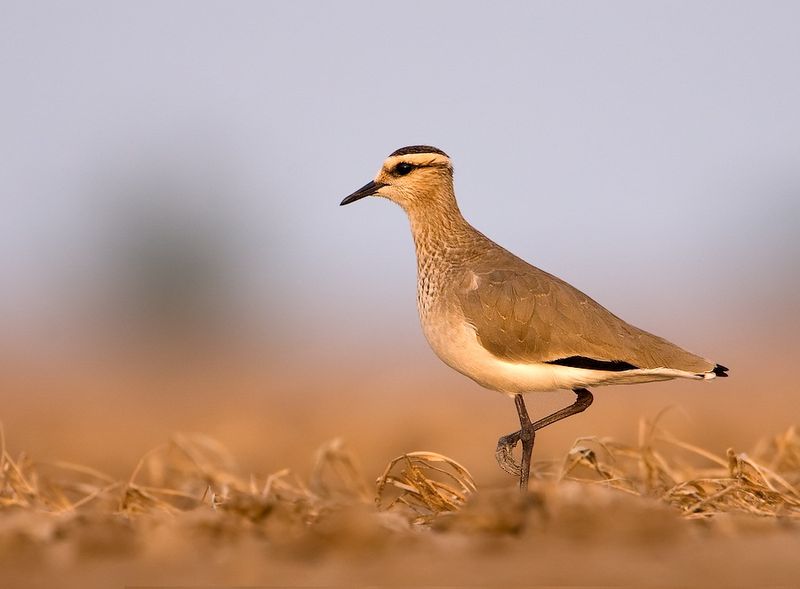
The Sociable Lapwing is an impressive wading bird of the plover family. It breeds in Kazakhstan, and migrates to spend its winter months in areas such as the Middle East, Indian Subcontinent, and Sudan.
Historically known as Black-bellied lapwing due to its black lower body feathers that contrast with white upper parts, it has a unique social behavior which earned it the name ‘Sociable’.
This species will often gather together into large flocks during migration but also form smaller groups while breeding or searching for food.
The male’s courtship display involves making loud calls from high places like rocks before diving down onto his chosen mate.
These birds are protected under international law since they have been hunted almost to extinction for their meat and feathers over past centuries.
Scientific classification:
| Kingdom | Animalia |
| Phylum | Chordata |
| Class | Aves |
| Order | Charadriiformes |
| Family | Charadriidae |
| Genus | Vanellus |
| Species | V. gregarius |
Also Featured In: Flight Birds You Should Know, Common Birds of Maharashtra
30. Syrian Serin
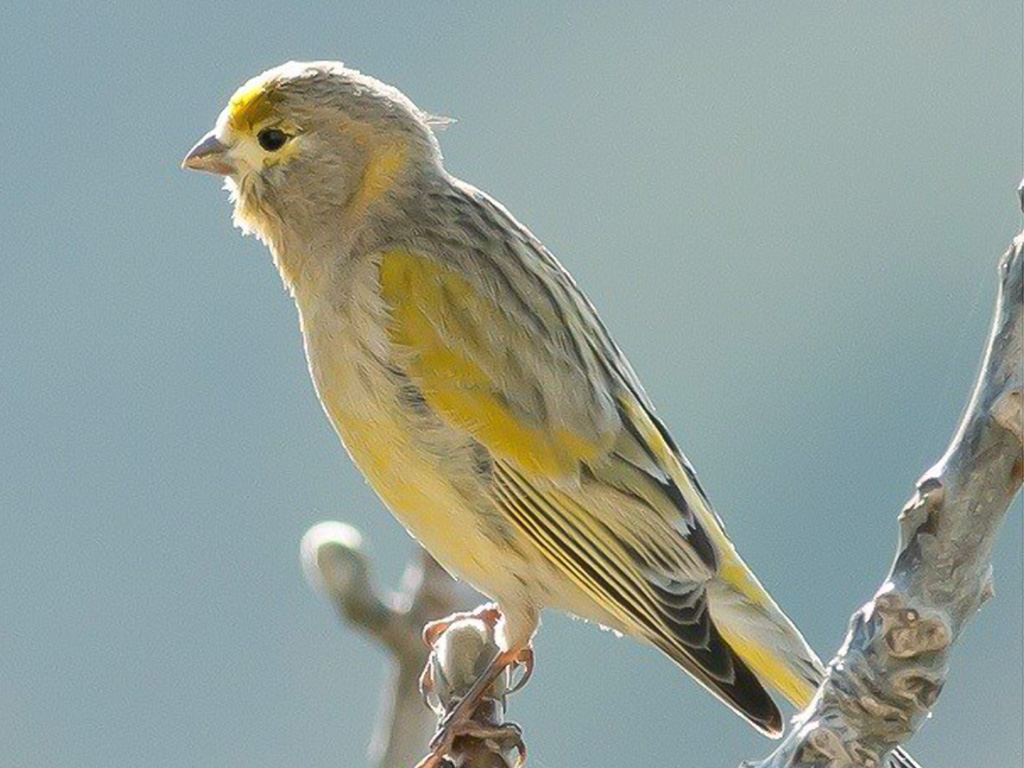
The Syrian serin is a beautiful finch bird with bright yellow and pale grey feathers, large eyes surrounded by a bright yellow ring, and a grey beak. Its legs are pinkish-grey in colour.
It has an endearing trilling call that carries far on the air along with occasional chirps or twitters.
This small passerine breeds mainly in Syria and continues to thrive there due to its varied diet of seeds from weeds as well as fruits found within their habitat range.
The Syrian Serin can often be seen flitting about bushes or trees where it builds nests made from grasses for nesting purposes during springtime mating season when male birds display colourful plumage for attracting mates.
Scientific classification:
| Kingdom | Animalia |
| Phylum | Chordata |
| Class | Aves |
| Order | Passeriformes |
| Family | Fringillidae |
| Subfamily | Carduelinae |
| Genus | Serinus |
| Species | S. syriacus |
Also Featured In: Syrian Birds You Need to Know, Lebanon Birds Live in Semi-Desert Areas
31. Red-Knobbed Coot
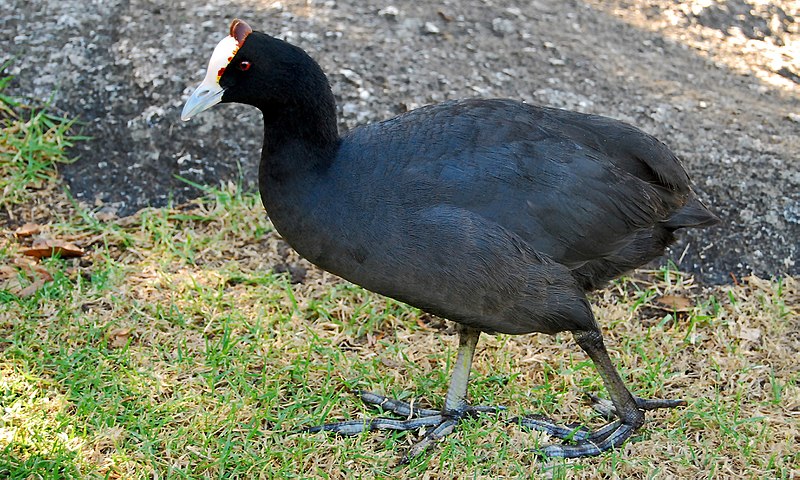
The Red-knobbed Coot is a species of rail and crake bird belonging to the Rallidae family. It is mostly found in Africa with presence in parts of southern Spain, breeding around freshwater lakes and ponds.
They build their nest from dead reeds near water’s edge or on floating platforms, laying about seven eggs but can lay more depending on environmental factors.
It was formally described by Italian ornithologist Giovanni Antonio Scopoli in 1786 as Fulica cristata which translates to “crested coot” due its distinctive red knob located above the bill that it uses for display purposes during courtship rituals.
The Red-knobbed Coot has a black body with white beak and feet, making them quite easy to spot amongst other birds native to similar habitats.
Scientific classification:
| Kingdom | Animalia |
| Phylum | Chordata |
| Class | Aves |
| Order | Gruiformes |
| Family | Rallidae |
| Genus | Fulica |
| Species | F. cristata |
32. Ortolan Bunting
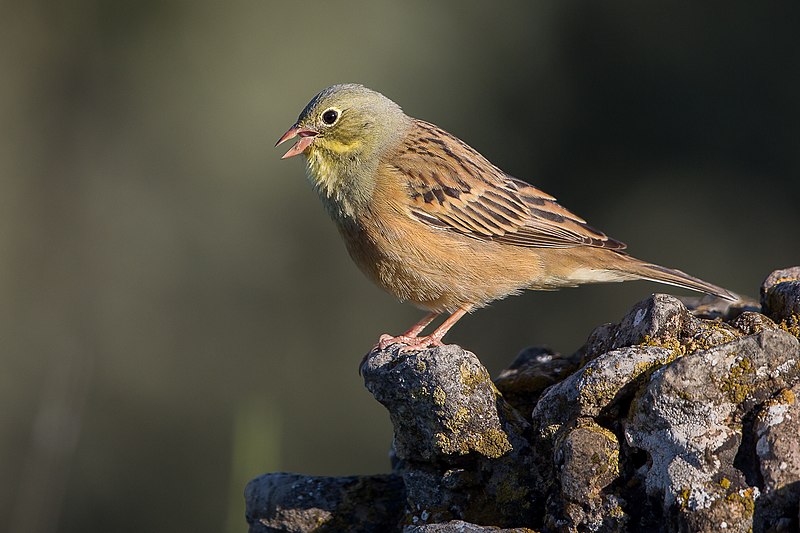
The Ortolan bunting is a small bird that can be found across Eurasia. It belongs to the Emberizidae family, which was once considered part of the finch family Fringillidae.
The genus name ‘Emberiza’ comes from Alemannic German Embritz, meaning a bunting while its species name hortulana is Italian for ortolana, or gardener. This beautiful songbird has brown upperparts and white underparts with bright yellow patches on both sides of its head and neck as well as black streaks all over its body.
Its wings are short but strong enabling it to have agile flight through dense vegetation in search for food such as insects and seeds.. A favourite delicacy amongst some cultures like French cuisine where they are baked whole with butter.
Scientific classification:
| Kingdom | Animalia |
| Phylum | Chordata |
| Class | Aves |
| Order | Passeriformes |
| Family | Emberizidae |
| Genus | Emberiza |
| Species | E. hortulana |
33. Bee-Eater

Bee-eaters are one of the most beautiful and vibrant birds in existence. They have a slender body, long wings, down turned bills and their signature elongated central tail feathers which make them instantly recognizable from afar.
Their plumage is incredibly colorful with many shades ranging from blues to greens to reds that glisten when they fly through the air.
These stunning creatures can be found all over Africa, Asia, Southern Europe, Australia and New Guinea where they feed mainly on bees but also other insects like flies or wasps as well as small mammals such as lizards or rodents.
Bee-eaters live in colonies near rivers or wetlands so that they may easily hunt for food while staying close together for safety purposes.
Additionally it allows them to better display their impressive courtship dances during mating season.
Scientific classification:
| Kingdom | Animalia |
| Phylum | Chordata |
| Class | Aves |
| Order | Coraciiformes |
| Family | Meropidae Rafinesque, 1815 |
34. Guineafowls
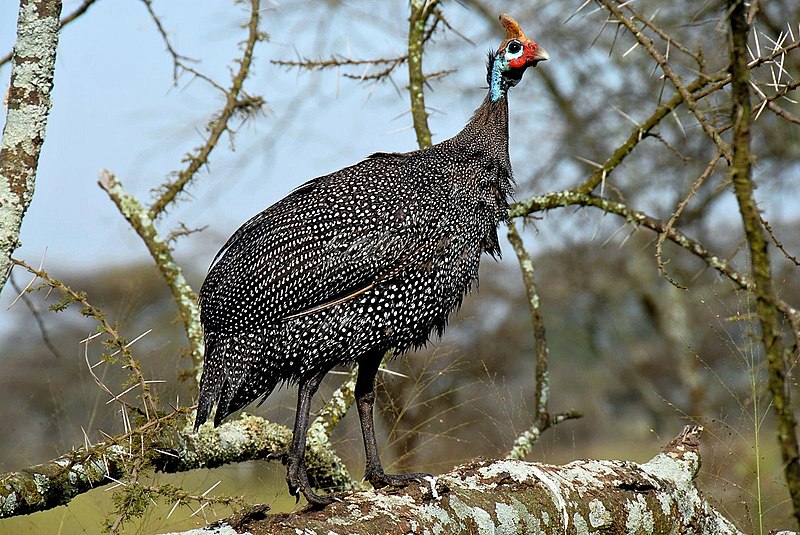
Guineafowls are a family of birds native to Africa and one of the oldest types of Galliformes. They have speckled feathers, long wattles on their necks, and small heads with bright red eyes.
These birds prefer open woodlands or savannas where they can feed on insects, seeds, berries and other forms of vegetation. A mature guineafowl can weigh up to 4 lbs., making them some of the largest members in the Numididae bird family.
Guineafowls use loud calls as a form communication between each other during breeding season when they gather together in large flocks for protection from predators such as hawks and humans which hunt them for food or sport.
Though not endangered yet this species is vulnerable due to habitat destruction so it’s important we protect these interesting animals that have been around since before recorded history.
Scientific classification:
| Kingdom | Animalia |
| Phylum | Chordata |
| Class | Aves |
| Order | Galliformes |
| Superfamily | Phasianoidea |
| Family | Numididae Longchamps, 1842 |
Also Featured In: African Birds, Birds that Live around Victoria
35. Isabelline Wheatear
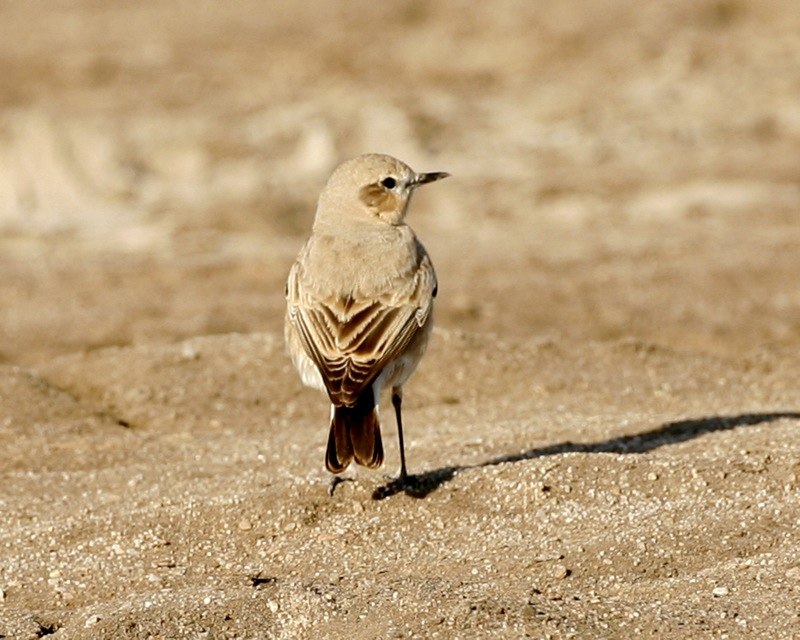
The Isabelline Wheatear is a small passerine bird belonging to the Muscicapidae family. It can be found in steppes and open countryside, breeding from southern Russia through Central Asia all the way down to northern Pakistan.
During wintertime it migrates southwards for warmer climates. Its diet mainly consists of insects which makes this species an insectivorous one.
Its usual hunting ground is on low vegetation or on bare soil where it searches for food with its agile movements and sharp bill.
The males are distinguished by their grey upperparts, light underside with buff markings around wings and tail as well as their white brow stripe that gives them their name: “Isabellina”.
Scientific classification:
| Kingdom | Animalia |
| Phylum | Chordata |
| Class | Aves |
| Order | Passeriformes |
| Family | Muscicapidae |
| Genus | Oenanthe |
| Species | O. isabellina |
Also Featured In: Common Cornwall Birds,
36. Masked Shrike
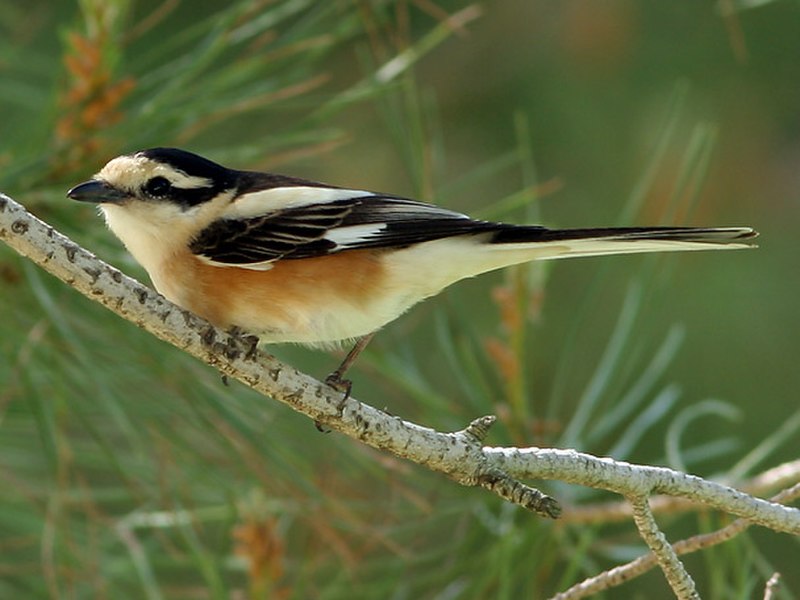
The Masked Shrike is a species of bird in the shrike family, found in southeastern Europe and the eastern Mediterranean. It breeds both in Iraq and Iran, before migrating to northeast Africa for winter.
This short-distance migrant can be seen as far away as northern and western Europe on occasions too.
The Masked Shrike sports an attractive black mask across its eyes with red patches near its bill. Its wings are greyish brown while it’s back is much darker – almost black.
An interesting feature about this beautiful bird is that it often impales prey onto thorns or barbed wire fences which they use as larders when food sources become scarce.
Scientific classification:
| Kingdom | Animalia |
| Phylum | Chordata |
| Class | Aves |
| Order | Passeriformes |
| Family | Laniidae |
| Genus | Lanius |
| Species | L. nubicus |
Also Featured In: Turkey Birds You Should Know,
37. Desert Lark
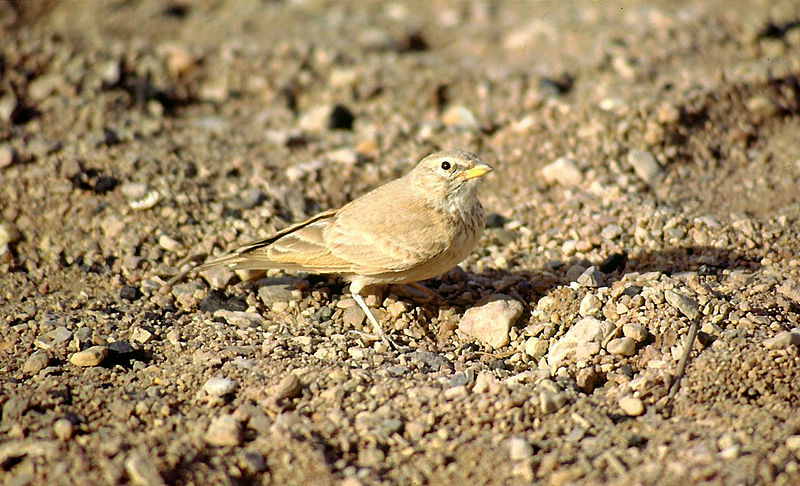
The Desert Lark is a species of bird found in the deserts and semi-deserts of Morocco to western India. It has an impressive distribution range, which only continues to grow as its population slowly increases.
Luckily they are not facing any serious threats, so their conservation status is currently rated as “least concern” by the International Union for Conservation of Nature.
They have a greyish brown plumage with white streaks on their wings and tail feathers that make them quite distinctive from other birds in the same region.
The desert lark also has black beaks and legs which contrast nicely against its coloured feathers – making it stand out even more.
Scientific classification:
| Kingdom | Animalia |
| Phylum | Chordata |
| Class | Aves |
| Order | Passeriformes |
| Family | Alaudidae |
| Genus | Ammomanes |
| Species | A. deserti |
Also Featured In: Birds that Live in the Deserts,
38. Jouanin’s Petrel
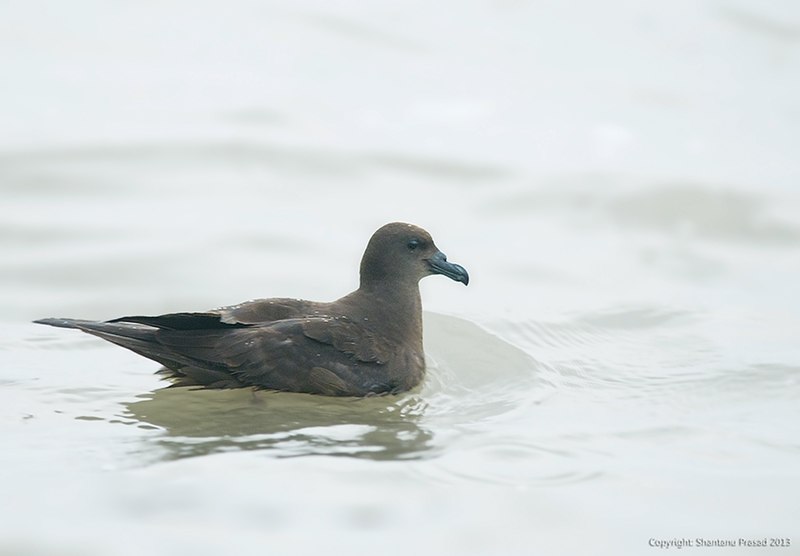
Jouanin’s petrels are seabirds belonging to the Procellariidae family. They inhabit open and shallow seas in the northwestern Indian Ocean, with their breeding grounds located on Socotra Island.
These birds have a distinctive blackish-brown plumage that covers most of its body except for the white rump and tail feathers which stand out against it.
Jouanin’s petrels typically feed on small fish, squid, krill or other crustaceans by diving into water from flight or swimming underwater using their webbed feet as paddles.
The species is considered endangered due to threats such as overfishing and oil spills in some areas where they live. Conservation efforts include reducing human disturbances near nesting sites so these lovely creatures can continue to thrive.
Scientific classification:
| Kingdom | Animalia |
| Phylum | Chordata |
| Class | Aves |
| Order | Procellariiformes |
| Family | Procellariidae |
| Genus | Bulweria |
| Species | B. fallax |
39. Rhynchostruthus
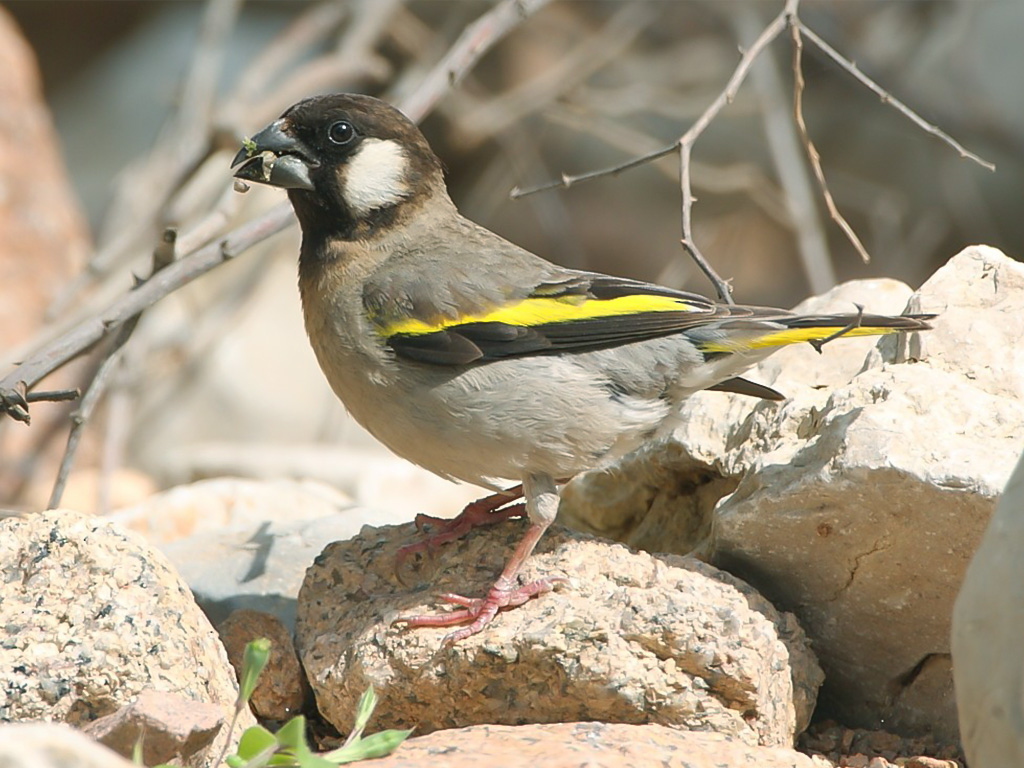
Rhynchostruthus is a beautiful, medium-sized bird found in the southern Arabian and northern Somalian regions. It’s characterized by its robust bill and attractive golden wings.
These elusive birds are usually located at altitudes between 1,060 and 2,800 metres ASL in forested wadis or areas of scrub vegetation where they feed on juniper fruits as well as acacias.
They can be identified by their unique call which resembles that of a squeaking wheelbarrow. Rhynchostruthus has been classified as an endangered species due to habitat destruction from deforestation activities.
Conservation efforts must therefore focus on protecting these stunning creatures if we wish to ensure their survival for future generations.
Scientific classification:
| Kingdom | Animalia |
| Phylum | Chordata |
| Class | Aves |
| Order | Passeriformes |
| Family | Fringillidae |
| Subfamily | Carduelinae |
| Genus | Rhynchostruthus P.L. Sclater & Hartlaub, 1881 |
40. Falcons And Caracaras
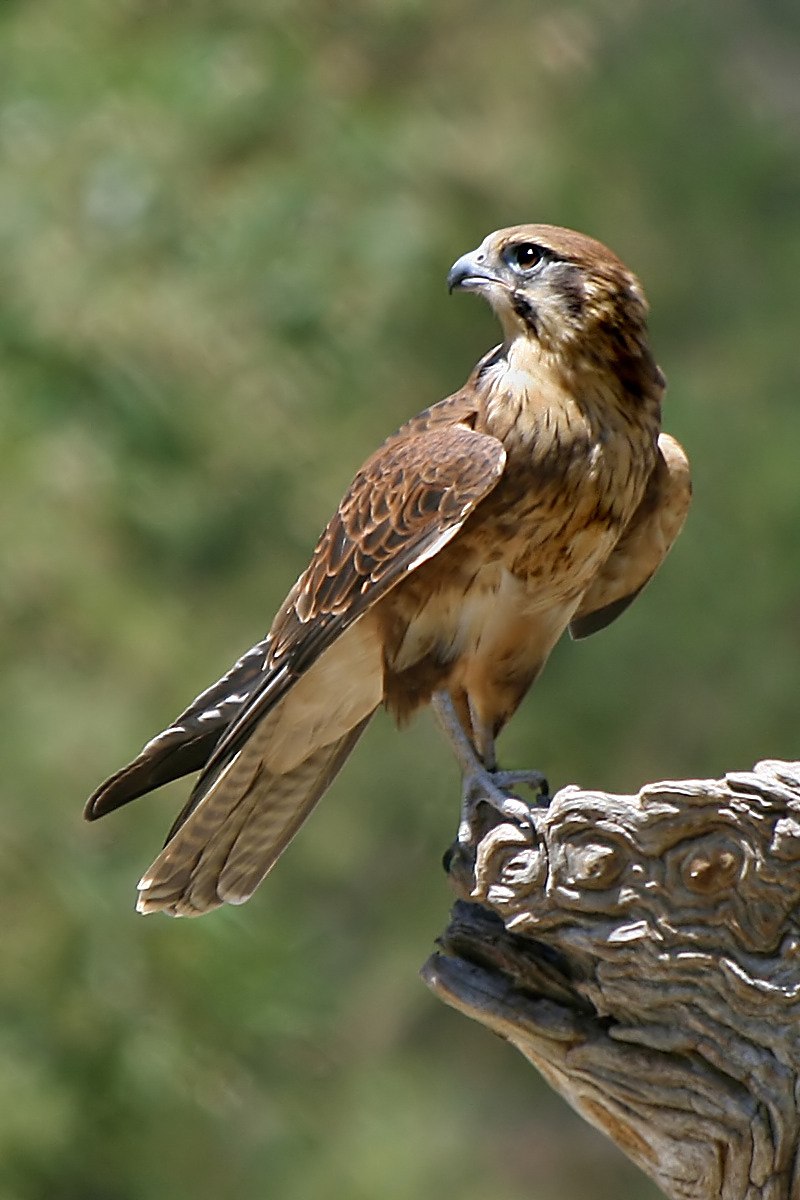
Falcons and caracaras are birds of prey that belong to the family Falconidae. They have impressive sharp talons, hooked beaks and keen eyesight which makes them excellent hunters.
Falcons can reach speeds up to 200 mph when diving for their prey while caracaras use a combination of running and flying to hunt small mammals such as rabbits or rats.
Both falcons and caracaras live in various areas around the world from grasslands, deserts, forests, wetlands or even urban areas where they nest on cliffs or tall buildings.
The diet mainly consists insects but also includes larger animals like reptiles or other birds which they catch by surprise with fast dives out of the sky.
Scientific classification:
| Kingdom | Animalia |
| Phylum | Chordata |
| Class | Aves |
| Order | Falconiformes |
| Family | Falconidae Leach, 1820 |
41. Sand Partridge
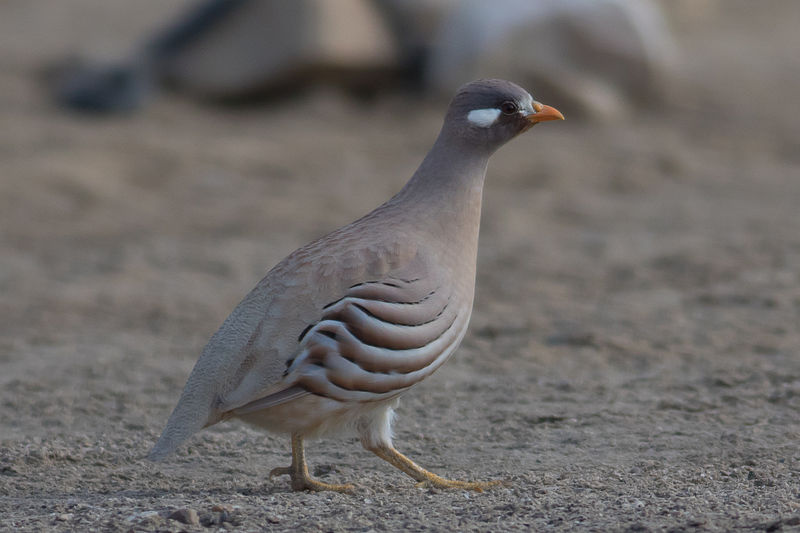
The Sand Partridge is a medium-sized gamebird belonging to the pheasant family, Phasianidae.
Native to Egypt and Israel eastwards down towards South Arabia, it measures 22–25 cm in length and is closely related to its counterpart from southeast Turkey through Pakistan – the See-See Partridge (Ammoperdix griseogularis).
This bird is a resident breed that prefers open habitats such as scrubland or desert with short vegetation for nesting purposes. Its diet consists mainly of insects but also includes seeds, plants and fruits.
It has white cheeks bordered by black stripes below each eye extending up onto its forehead region; along with other distinguishing features like streaked brown plumage on its back, wings and tail feathers helping them blend into their natural surroundings perfectly.
Scientific classification:
| Kingdom | Animalia |
| Phylum | Chordata |
| Class | Aves |
| Order | Galliformes |
| Family | Phasianidae |
| Genus | Ammoperdix |
| Species | A. heyi |
42. Montane Nightjar
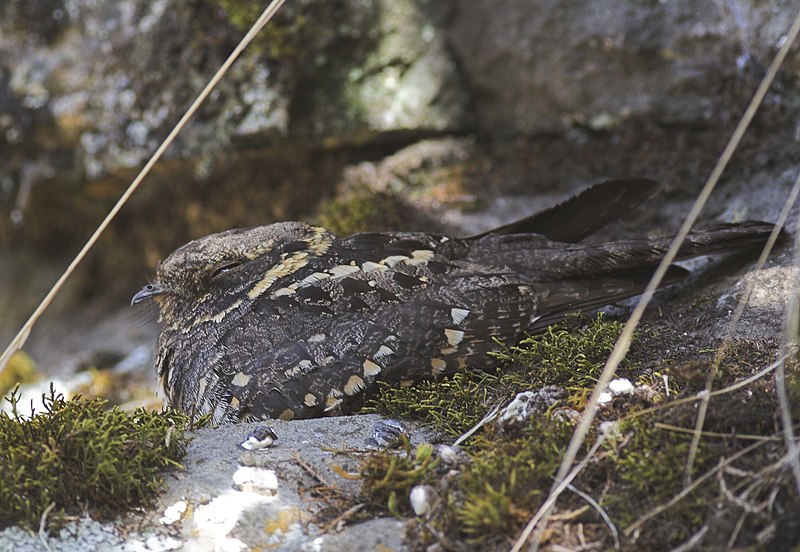
The Montane nightjar is a species of bird found in central and eastern Africa, living in upland regions. It was first described by German naturalist Eduard Rüppell back in 1840 under the scientific name Caprimulgus poliocephalus.
This medium-sized nocturnal bird has mottled greyish brown plumage with white spots on its wings and tail feathers, along with a distinctive black cap on top of its head that gives it the nickname “Abyssinian Nightjar”.
The montane nightjar feeds on insects during the evening hours but can also be seen perched atop trees or shrubs during daytime when they’re resting or basking in sunlight.
They are quite common throughout their range and make an interesting sight for any birder.
Scientific classification:
| Kingdom | Animalia |
| Phylum | Chordata |
| Class | Aves |
| Order | Caprimulgiformes |
| Family | Caprimulgidae |
| Genus | Caprimulgus |
| Species | C. poliocephalus |
43. Thick-Billed Warbler
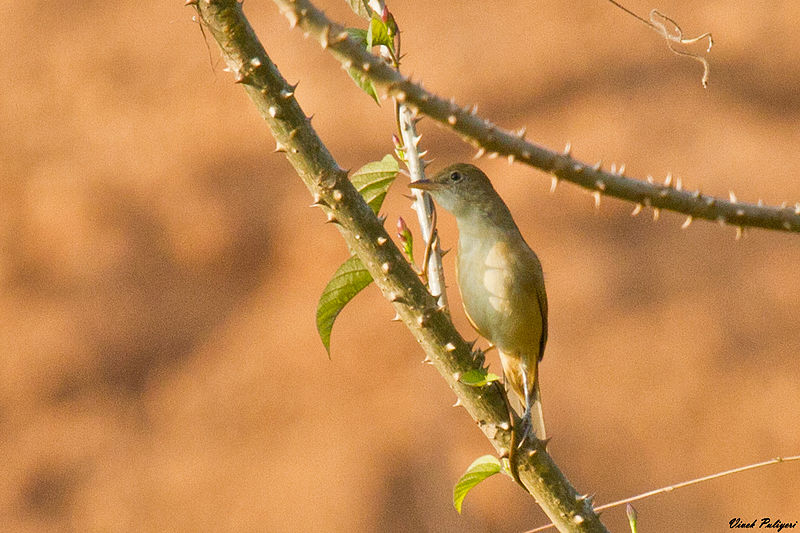
The Thick-billed Warbler is a species of passerine bird found in the temperate east Palearctic region, from south Siberia to west Mongolia. In winter it migrates to tropical South Asia and South-east Asia.
It prefers dense vegetation such as reeds, bushes and thick undergrowth for breeding habitats. The nest is usually built low down in a tree and five or six eggs are laid inside it.
This plump little warbler has an olive brown back with yellowish wings and tail feathers which contrast nicely against its grey head, white throat patch around the bill area plus yellow eyebrows above bright orange eyes.
Its song consists of loud whistles that can be heard up to half a mile away during summer months.
Scientific classification:
| Kingdom | Animalia |
| Phylum | Chordata |
| Class | Aves |
| Order | Passeriformes |
| Family | Acrocephalidae |
| Genus | Arundinax Blyth, 1845 |
| Species | A. aedon |
Also Featured In: Birds That You’ll See in Kaziranga National Park,
44. Buttonquail
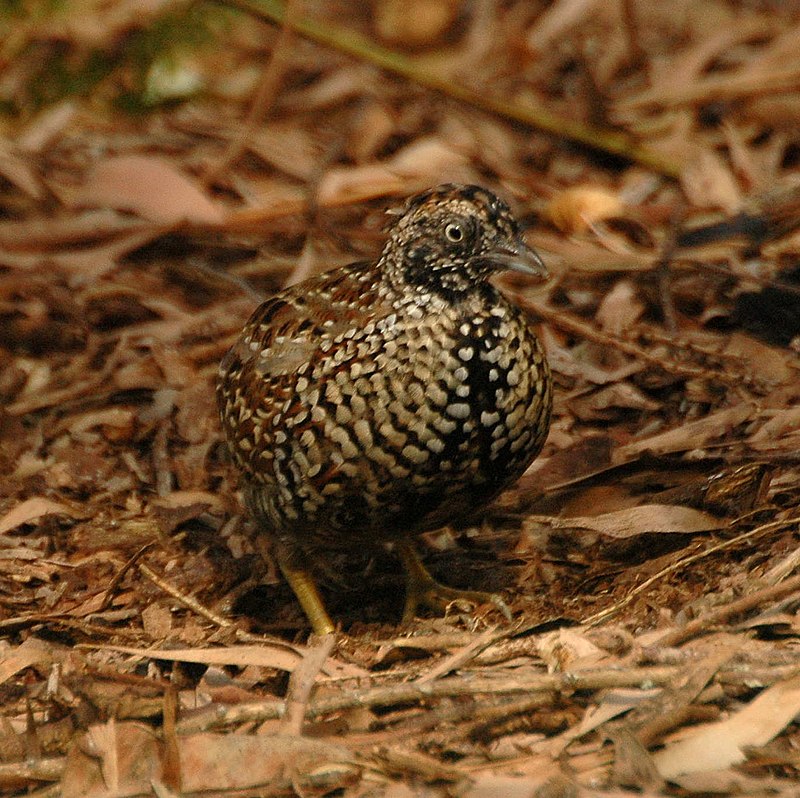
Buttonquails are small, terrestrial birds belonging to the family Turnicidae. They can be found in warm grasslands of Asia, Africa, Europe and Australia.
There are 18 species found across two genera; most being placed under the genus Turnix with a single species known as Ortyxelos.
These birds share a superficial resemblance to quail from Phasianidae but lack any close relation.
Buttonquails avoid flying and instead prefer running on their short legs for navigational purposes.
In terms of physicality they have drab colouring which comprises mostly browns or greys whilst sporting distinctive white patches around their eyes making them easy to identify within dense foliage areas where they usually hide away during times of danger or distress.
Scientific classification:
| Kingdom | Animalia |
| Phylum | Chordata |
| Class | Aves |
| Order | Charadriiformes |
| Family | Turnicidae GR Gray, 1840 |
45. Northern Storm Petrels
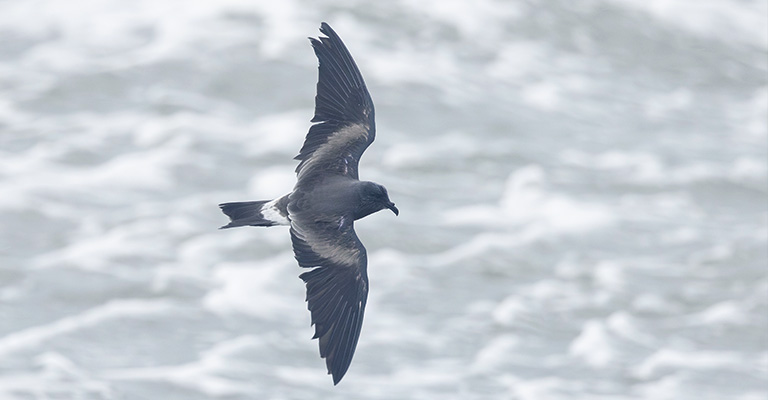
Northern storm petrels are one of the smallest seabirds, inhabiting oceans all over the world.
They have a unique ability to hover over water and pick planktonic crustaceans and small fish from the surface.
Northern storm petrels belong to the genus Hydrobates in family Hydrobatidae, part of Procellariiformes order.
This species was once lumped with austral storm petrel but recent studies show that they weren’t related closely which led them being split into two distinct species now.
These birds can be identified by their dark grey upperparts and wings along with white underparts when seen from afar while feeding on ocean’s surface.
Scientific classification:
| Kingdom | Animalia |
| Phylum | Chordata |
| Class | Aves |
| Order | Procellariiformes |
| Family | Hydrobatidae Mathews, 1912 |
| Genus | Hydrobates F. Boie, 1822 |
46. Procellariidae
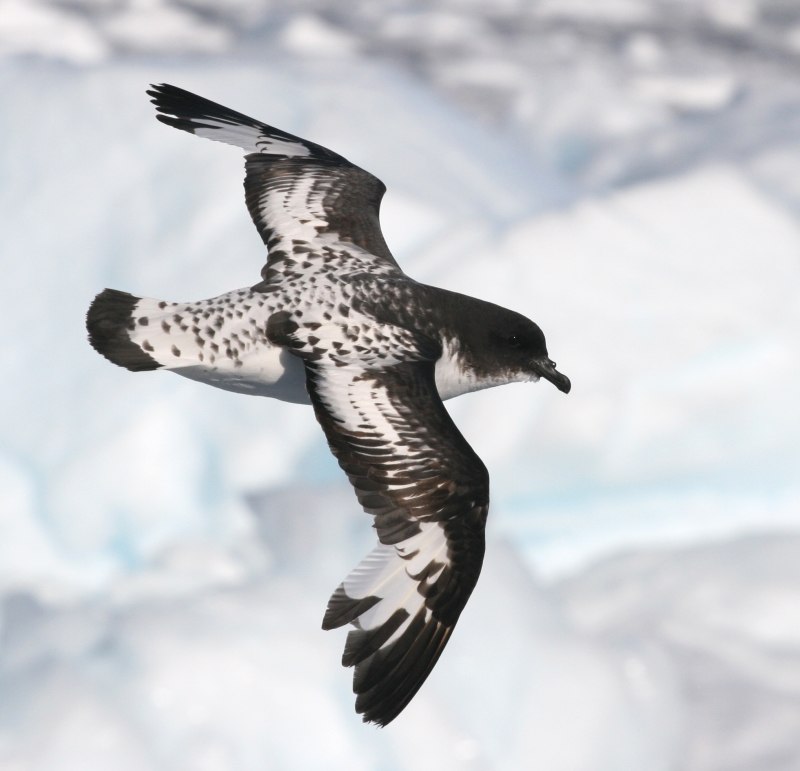
Procellariidae is a diverse family of seabirds belonging to the bird order Procellariiformes.
These birds are commonly referred to as tubenoses and include fulmarine petrels, gadfly petrels, diving petrels, prions, and shearwaters.
They range in size from the small storm-petrel which measures around 18cm long to the giant albatross which can reach up to 3 meters in length.
Generally found near oceans or coasts where they feed on fish as well as squid and other marine life depending on species.
Many procellariids will also nest inland during breeding season before returning back out at sea for most of their lives.
Their wings have specially adapted feathers that give them incredible gliding abilities allowing them literally fly with minimal effort over vast distances across oceanic regions.
Scientific classification:
| Kingdom | Animalia |
| Phylum | Chordata |
| Class | Aves |
| Order | Procellariiformes |
| Family | Procellariidae Leach, 1820 |
47. Stilts And Avocets
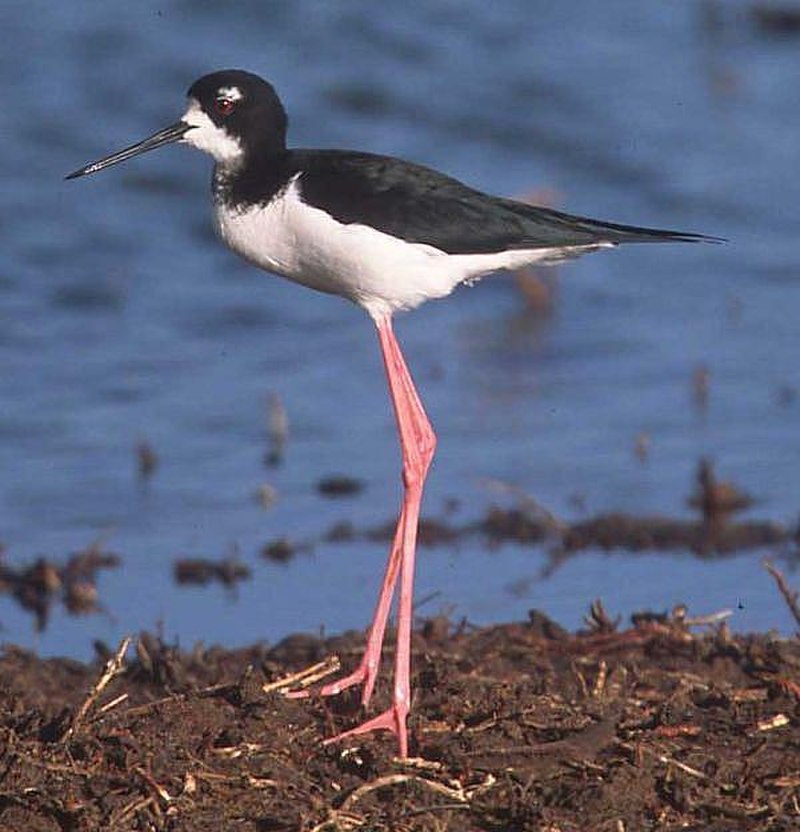
Stilts and avocets are two distinct groups of birds belonging to the family Recurvirostridae. They range in length from 30-46 cm (12-18 inches) and weigh between 140 – 435 g (4.9 – 15.3 ounces).
Males usually have slightly larger bodies than females, with long thin legs, necks and bills.
Avocet bills curve upwards uniquely while stilt beaks remain straight most times.
These wading birds live mainly near shorelines or wetlands where they feed on aquatic invertebrates like brine shrimp, insects etc., occasionally supplementing their diet with seeds or small fish too.
Stilts also inhabit open fields in search of food sources such as earthworms or grasshoppers during the non-breeding season.
Both groups migrate over large distances for warmer weathers when it gets cold outside.
Scientific classification:
| Kingdom | Animalia |
| Phylum | Chordata |
| Class | Aves |
| Order | Charadriiformes |
| Suborder | Charadrii |
| Family | Recurvirostridae Bonaparte, 1854 |
48. Glareolidae
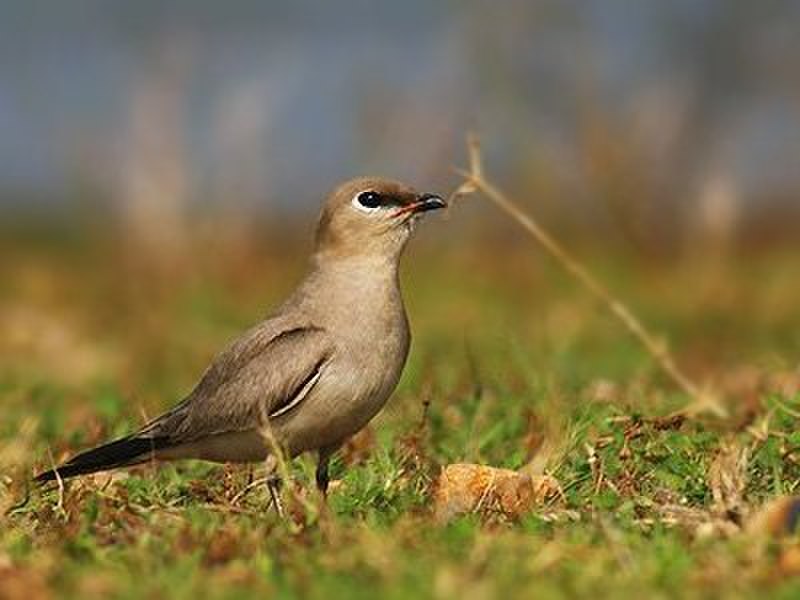
Glareolidae is a family of wading birds, consisting of four genera and 17 species. They are distinguished from other charadrii by their long bills which have a slight downward curve.
Glareolidae live around open grasslands and deserts, where they hunt for insects using the bill to probe into soil or vegetation.
Most species are found in Africa but two pratincoles inhabit parts of Europe and Asia as well.
Coursers tend to be larger than pratincoles with longer legs allowing them to run quickly across sandy dunes while feeding on small animals like lizards or spiders.
Pratincoles feed mainly on flying insects, snatching them out of midair with great agility during flight.
All glareolids share unique features such as large eyes that help it spot prey at night easily making this group one interesting bird family.
Scientific classification:
| Kingdom | Animalia |
| Phylum | Chordata |
| Class | Aves |
| Order | Charadriiformes |
| Suborder | Lari |
| Family | Glareolidae CL Brehm, 1831 |
49. Monarch Flycatcher
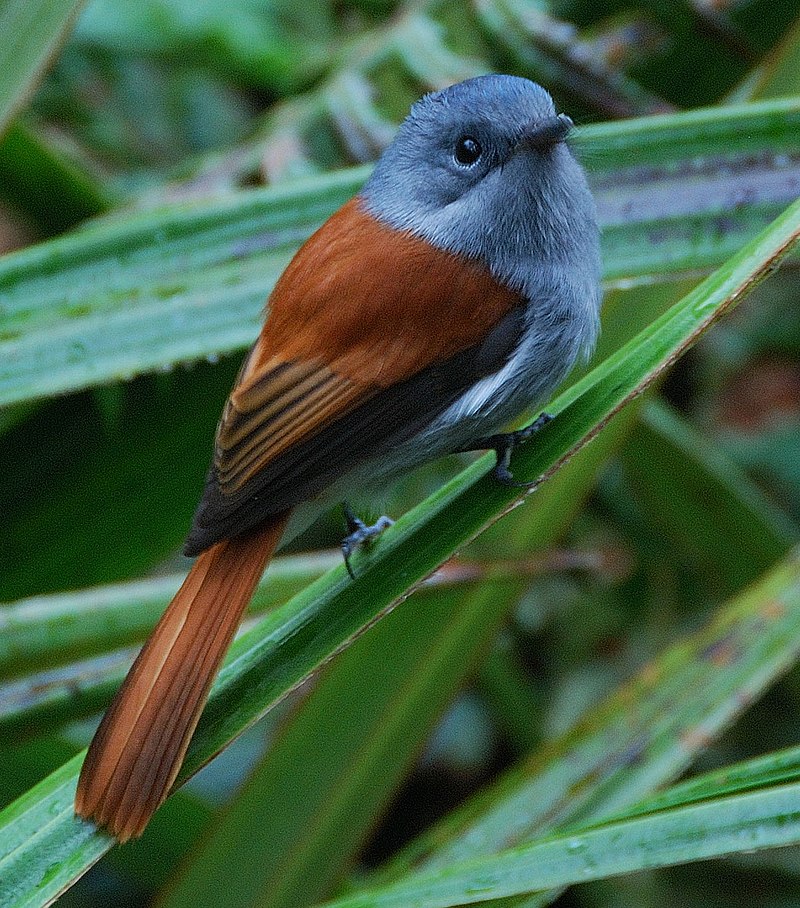
The Monarch flycatcher is a small passerine bird, belonging to the family Monarchidae. It inhabits forest or woodland areas across sub-Saharan Africa, south-east Asia, Australasia and various Pacific islands.
Only some species migrate seasonally. This beautiful little bird has a long tail and feeds mainly on insects it catches in its beak.
Its cup shaped nest can often be found hanging from branches high up in trees where they are safe from predators while incubating their eggs – usually between two to four of them at once.
The adult birds have attractive plumage with hues of blues and greens along with white patches near their tails which make for stunning displays when they take flight during mating season or migratory times.
Scientific classification:
| Kingdom | Animalia |
| Phylum | Chordata |
| Class | Aves |
| Order | Passeriformes |
| Superfamily | Corvoidea |
| Family | Monarchidae Bonaparte, 1854 |
Also Featured In: Guam Birds You Need to See, Most Common Taiwan Birds
50. Sylviid Warblers
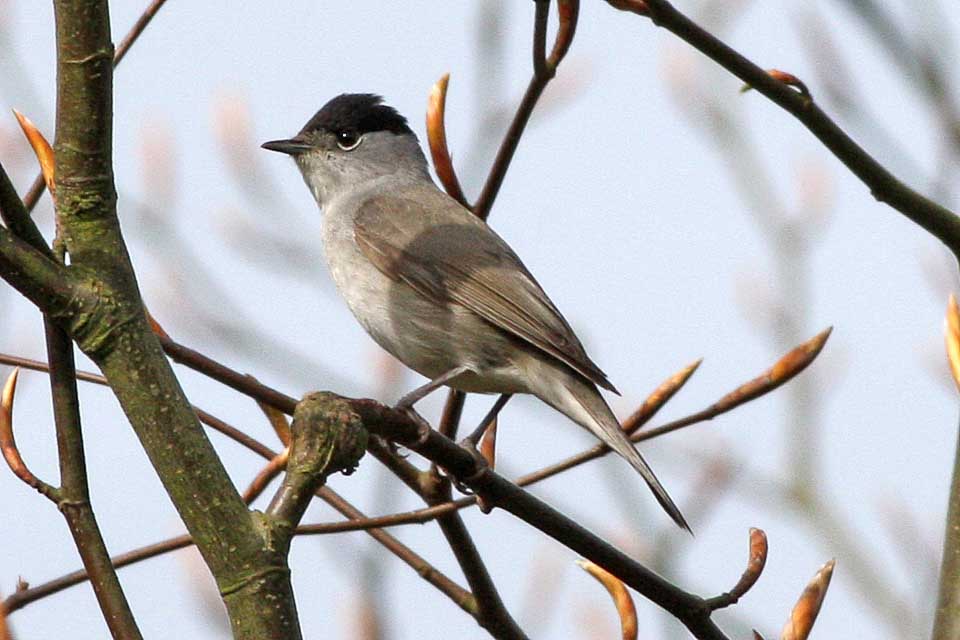
The Sylviid warblers are a family of passerine birds found in Eurasia and Africa. They include the typical warblers as well as babblers that were formerly part of the Old World babbler family.
These birds have slender bodies, pointed wings, long tails and strong legs adapted for ground-dwelling habits like running or hopping along branches.
The male often has bright colors while females are usually duller in coloration with more muted plumage patterns than males.
Some species also show sexual dimorphism where one sex may be larger or smaller than its counterpart; for instance some species may have longer tail feathers on the female side compared to their male counterparts.
Many members of this group feed on insects but some specialize on seeds, fruits, nectar or even frogs.
Scientific classification:
| Kingdom | Animalia |
| Phylum | Chordata |
| Class | Aves |
| Order | Passeriformes |
| Superfamily | Sylvioidea |
| Family | Sylviidae Leach, 1820 |